J. Korean Math. Soc. 39 (2002), No. 4, pp. 621–651 (f, 2)–ROTATIONAL EXTENDED STEINER TRI
- 格式:pdf
- 大小:224.04 KB
- 文档页数:31
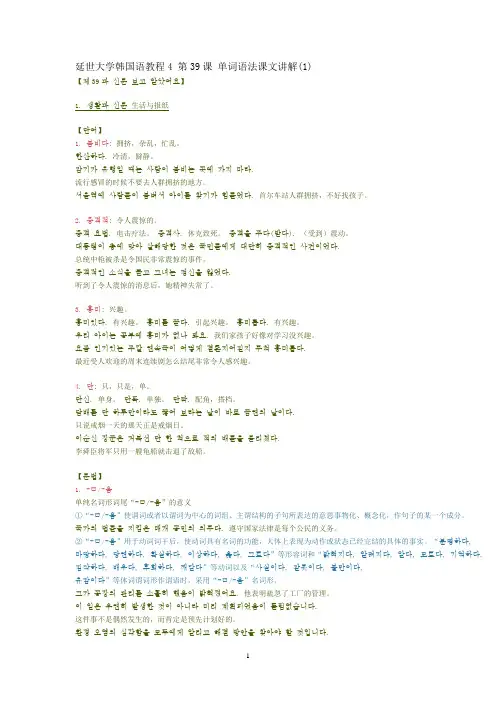
延世大学韩国语教程4 第39课单词语法课文讲解(1)【제39과신문보고알았어요】1. 생활과신문生活与报纸【단어】1. 붐비다: 拥挤,杂乱,忙乱。
한산하다. 冷清,僻静。
감기가유행일때는사람이붐비는곳에가지마라.流行感冒的时候不要去人群拥挤的地方。
서울역에사람들이붐벼서아이를찾기가힘들었다. 首尔车站人群拥挤,不好找孩子。
2. 충격적: 令人震惊的。
충격요법. 电击疗法。
충격사. 休克致死。
충격을주다(받다). (受到)震动。
대통령이총에맞아살해당한것은국민들에게대단히충격적인사건이었다.总统中枪被杀是令国民非常震惊的事件。
충격적인소식을듣고그녀는정신을잃었다.听到了令人震惊的消息后,她精神失常了。
3. 흥미: 兴趣。
흥미있다. 有兴趣。
흥미를끌다. 引起兴趣。
흥미롭다. 有兴趣。
우리아이는공부에흥미가없나봐요. 我们家孩子好像对学习没兴趣。
요즘인기있는주말연속극이어떻게결론지어질지무척흥미롭다.最近受人欢迎的周末连续剧怎么结尾非常令人感兴趣。
4. 단: 只,只是,单。
단신. 单身。
단독. 单独。
단짝. 配角,搭档。
담배를단하루만이라도끊어보라는날이바로금연의날이다.只说戒烟一天的那天正是戒烟日。
이순신장군은거북선단한척으로적의배들을물리쳤다.李舜臣将军只用一艘龟船就击退了敌船。
【문법】1. -ㅁ/-음单纯名词形词尾“-ㅁ/-음”的意义①“-ㅁ/-음”使谓词或者以谓词为中心的词组、主谓结构的子句所表达的意思事物化、概念化,作句子的某一个成分。
국가의법률을지킴은매개공민의의무다. 遵守国家法律是每个公民的义务。
②“-ㅁ/-음”用于动词词干后,使动词具有名词的功能,大体上表现为动作或状态已经完结的具体的事实。
“분명하다,마땅하다, 당연하다, 확실하다, 이상하다, 옳다, 그르다”等形容词和“밝혀지다, 알려지다, 알다, 모르다, 기억하다, 짐작하다, 배우다, 후회하다, 깨닫다”等动词以及“사실이다, 잘못이다, 불만이다,유감이다”等体词谓词形作谓语时,采用“-ㅁ/-음”名词形。
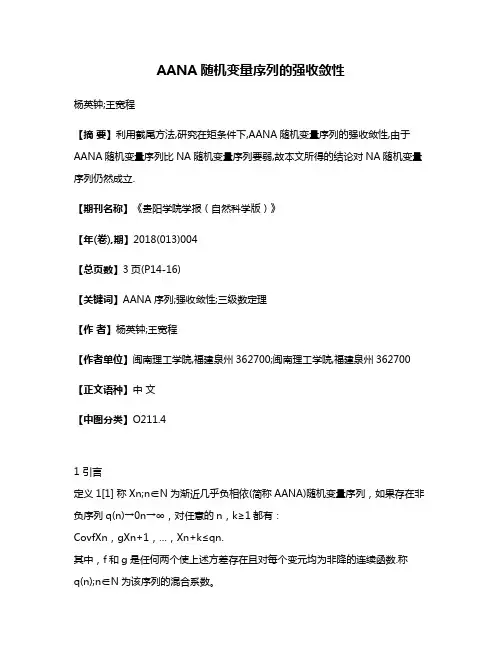
AANA随机变量序列的强收敛性杨英钟;王宽程【摘要】利用截尾方法,研究在矩条件下,AANA随机变量序列的强收敛性,由于AANA随机变量序列比NA随机变量序列要弱,故本文所得的结论对NA随机变量序列仍然成立.【期刊名称】《贵阳学院学报(自然科学版)》【年(卷),期】2018(013)004【总页数】3页(P14-16)【关键词】AANA序列;强收敛性;三级数定理【作者】杨英钟;王宽程【作者单位】闽南理工学院,福建泉州362700;闽南理工学院,福建泉州362700【正文语种】中文【中图分类】O211.41 引言定义1[1] 称Xn;n∈N为渐近几乎负相依(简称AANA)随机变量序列,如果存在非负序列q(n)→0n→∞,对任意的n,k≥1都有:CovfXn,gXn+1,…,Xn+k≤qn.其中,f和g是任何两个使上述方差存在且对每个变元均为非降的连续函数.称q(n);n∈N为该序列的混合系数。
AANA序列是一类广泛的负相依序列,文献[1]介绍了AANA序列的定义并指出NA序列[2]是AANA序列,其混合系数满足(q(n)=0,n≥1),反之不真,文中还举出了一些例子.因此研究AANA序列的收敛性质是十分有意义的.有关更多AANA序列的成果,可以参见文献[3-10] .本文利用随机变量的截尾方法,研究矩条件下AANA序列的强收敛性.由于AANA序列比NA序列更弱,因此本文所得的结论对NA序列仍然成立.本文一律以C记与n无关的正实数,且C在不同的地方可表示不一样的值,即使在同一个式子里也是如此,记Sn,“≤”表示通常的大“O”。
2 所需引理引理1[1] 设Xn;n∈N为AANA序列,并且混合系数是q(n);n∈N,若fn;n∈N 皆是单调非降(或者单调非增)连续函数,那么f nxn;n∈N仍然是AANA序列,其混合系数仍然是q(n);n∈N.引理2[6]设Xn;n∈N为零均值的AANA序列,当1<p≤2时,混合系数q(n);n∈N,那么存在仅依赖于p的正数Cp,使得≤.引理3[11] 令Xn,n≥1为AANA随机变量序列,混合系数为qn,n≥1满足∞.令c为某个正数,记Yn=XnIXn≤c,n≥1.如果满足-∞∞,∞,∞,则收敛, a.s.3 定理及其证明定理1 设Xn,n≥1为零均值的AANA随机变量序列,混合系数为qn,n≥1满足∞,如果下列二条件之一成立:∞,0<β≤1,(1)∞,1≤β≤2.(2)其中M>0,an是常数列且满足0≤an↑∞,则.证明:当β>0,Xn≥Man>0时,有≥1,从而PXn≥Man=EIXn≥Man≤.由(1)式可得∞.当β≥1,Xn≥Man>0时,有≥1,由(2)式同样可得∞.从而当(1)式或(2)式成立时,有∞.(3)记.由引理1知,仍是AANA随机变量序列,从而是AANA的. 对0<β<1,有≤ManEIXn>Man+EXnIXn≤Man≤≤≤.对β≥1,由EXn=0,有≤EManIXn>Man+EXnIXn≤Man ≤≤≤.所以当(1)式或(2)式成立时,均有∞.(4)最后,如果0<β≤2,由Cr不等式有≤因而如果(1)式成立,则有≤∞.如果(2)式成立,则有≤∞.总之都有∞ .(5)由(3)—(5)式及引理3可知.s收敛.再由Kronecker引理有.推论1令Xn,n≥1为零均值的AANA随机变量序列,混合系数为qn,n≥1满足∞,设an,n≥1是一常数列,且满足0<an↑∞,若存在某个β∈1,2,使得∞,则.说明推论1给出了与独立情形相类似的经典强大数定律[12] .推论2 令Xn,n≥1为零均值的AANA随机变量序列,混合系数为qn,n≥1满足∞,设an是一常数列,满足0<an↑∞,bn是正实数序列且∞,如果存在r≥2,使得∞,则.证明:当r=2时,由推论1 结论成立,现设r>2,记.于是有.从而有hn=hnIhn≤bn+hnIhn>bn≤≤.由假设可得∞,又因为≤故由推论1知结论成立,说明如果我们令qn=0,n≥1,则AANA可变为NA列,因此以上定理及推论对于NA列仍然成立。
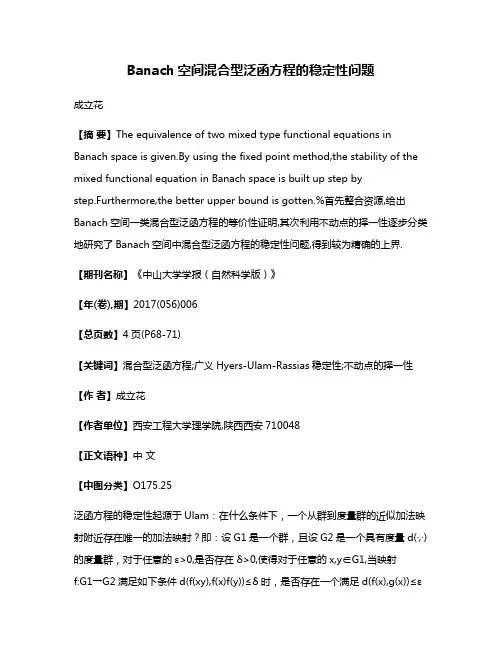
Banach空间混合型泛函方程的稳定性问题成立花【摘要】The equivalence of two mixed type functional equations in Banach space is given.By using the fixed point method,the stability of the mixed functional equation in Banach space is built up step bystep.Furthermore,the better upper bound is gotten.%首先整合资源,给出Banach空间一类混合型泛函方程的等价性证明,其次利用不动点的择一性逐步分类地研究了Banach空间中混合型泛函方程的稳定性问题,得到较为精确的上界.【期刊名称】《中山大学学报(自然科学版)》【年(卷),期】2017(056)006【总页数】4页(P68-71)【关键词】混合型泛函方程;广义Hyers-Ulam-Rassias稳定性;不动点的择一性【作者】成立花【作者单位】西安工程大学理学院,陕西西安710048【正文语种】中文【中图分类】O175.25泛函方程的稳定性起源于Ulam:在什么条件下,一个从群到度量群的近似加法映射附近存在唯一的加法映射?即:设G1是一个群,且设G2是一个具有度量d(·,·)的度量群,对于任意的ε>0,是否存在δ>0,使得对于任意的x,y∈G1,当映射f:G1→G2满足如下条件d(f(xy),f(x)f(y))≤δ时,是否存在一个满足d(f(x),g(x))≤ε的群同态g:G1→G2?紧接着,Hyers关于可加函数在Banach空间的稳定性问题给出肯定性的答案。
随之,一大批数学家开始在各种特殊空间提出特定的泛函方程的存在性问题[1-8]。
也有学者专注研究特定空间中单次或混合型泛函方程的稳定性问题或广义稳定性(Hyers-Ulam-Rassias) (简称HUR)问题[3-5]。
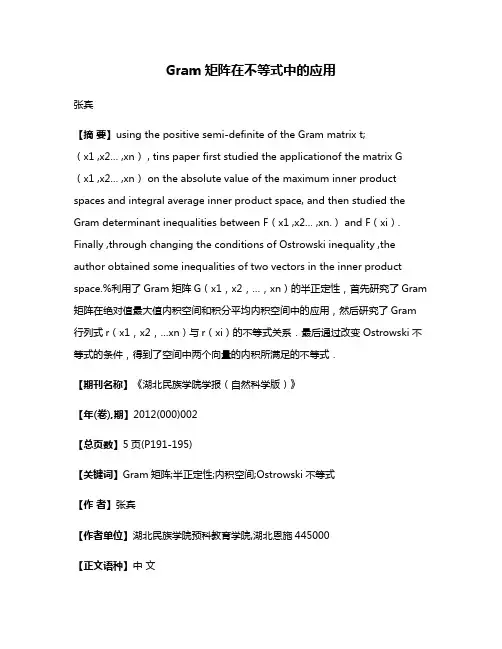
Gram矩阵在不等式中的应用张宾【摘要】using the positive semi-definite of the Gram matrix t;(x1 ,x2… ,xn) , tins paper first studied the applicationof the matrix G(x1 ,x2… ,xn) on the absolute value of the maximum inner product spaces and integral average inner product space, and then studied the Gram determinant inequalities between F(x1 ,x2… ,xn.) and F(xi). Finally ,through changing the conditions of Ostrowski inequality ,the author obtained some inequalities of two vectors in the inner product space.%利用了Gram矩阵G(x1,x2,…,xn)的半正定性,首先研究了Gram 矩阵在绝对值最大值内积空间和积分平均内积空间中的应用,然后研究了Gram 行列式r(x1,x2,…xn)与r(xi)的不等式关系.最后通过改变Ostrowski不等式的条件,得到了空间中两个向量的内积所满足的不等式.【期刊名称】《湖北民族学院学报(自然科学版)》【年(卷),期】2012(000)002【总页数】5页(P191-195)【关键词】Gram矩阵;半正定性;内积空间;Ostrowski不等式【作者】张宾【作者单位】湖北民族学院预科教育学院,湖北恩施445000【正文语种】中文【中图分类】O151定义1[1] 设x1,x2,…,xn是内积空间中的n个向量,矩阵:称为由x1,x2,…,xn生成的Gram矩阵.通常用G(x1,x2,…,xn)来记上述Gram矩阵.其行列式称为Gram行列式,通常用Γ(x1,x2,…,xn)表示.引理1[5] 设x1,x2,…,xn是内积空间中的n个向量,则G(x1,x2,…,xn)为半正定矩阵,当且仅当x1,x2,…,xn线性无关时G(x1,x2,…,xn)为正定的.引理2 设x,y,z是实内积空间中的三个非零向量,则:注:由引理1和引理2可得式(1)当且仅当x1,x2,…,xn线性相关时等号成立.引理3[6] 设f是区间[0,1]上的正实值函数,f是严格对数凸函数且在区间(0,1)上严格单调递减,x,y,z,ω∈[0,1],ω≤xyz,则有:其中引理4(Ostrowski不等式)[2] 设a=(a1,a2,…,an),b=(b1,b2,…,bn)是两个线性无关的n维向量,若x=(x1,x2,…,xn)满足(x,a)=0,(x,b)=1,则有等号成立当且仅当定理1 设x,y是实内积空间中的向量,若x=(ξ1,ξ2,…,ξn),y=(η1,η2,…,ηn),则有:其中1≤i≤n.证明定义实内积空间的内积为设zi=(0,…,0,1,0,…,0),其中第i个分量为1,其余分量为0,则在此内积空间中(x,zi)=|ξi|,(y,zi)=|ηi|,‖zi‖=1,由式(1):(1)代入可得:其中1≤i≤n.注:类似的可进一步得到在无穷维实内积空间中:其中i≥1.定理2 设f,g是区间(a,b)上的Lebesgue可积函数,满足:m≤f(x)≤M,n≤g(x)≤N,∀x∈(a,b),其中m+M≠0,n+N≠0,则有:证明在L2(a,b)上定义内积由此内积定义可得:由式(1)得:整理得:|‖g‖2(f,1)-(f,g)(g,1)|≤‖f‖dist(g,Span{f})dist(g,Span{1})≤‖g‖dist(f,Span{g})dist(g,Span{1}).代入得:‖f‖dist(g,Span{f})dist(g,Span{1})≤(b-a)2‖g‖dist(f,Span{g})dist(g,Span{1})由题设m≤f(x)≤M,n≤g(x)≤N,∀x∈(a,b)得:因此进而可得:‖f-sg‖≤‖‖‖‖‖‖≤dist(f,Span{g})=‖g-sf‖≤‖g-‖+‖-sf‖≤+‖f-‖≤+.记由内积定义可得: ‖f‖‖g‖由引理2可知‖f‖dist(g,Span{f})=‖g‖dist(f,Span{g}).从而有:≜综上可得结论:定理3 设x1,x2,…,xn为内积空间中的向量,‖xi‖≤1,则有:其中证明因为Γ(x1,x2,…,xn)≤Γ(x1)Γ(x2)…Γ(xn).由Gram矩阵的性质知,这些行列式都非负且小于等于1,所以:Γα(x1,x2,…,xn)≤Γα(x1)Γα(x2)…Γα(xn),其中α≥0,结合引理3得:其中注:同理可得下面结论.定理4 设x1,x2,…,xn为内积空间中的向量,‖xi‖≤1,1≤k≤n,则有:其中根据引理4(Ostrowski不等式)[2]和引理2可得以下结论:定理5 设a,b,x是实内积空间的三个非零向量,满足(a,x)=0,‖x‖=1,则有:当且仅当时等号成立.证明在式(1)中用a,b,x代替式(1)中的x,y,z得:因为(a,x)=0,‖x‖=1,故(a,b)2≤‖a‖2[‖b‖2-(b,x)2],从而有等号成立当且仅当a,b,x线性相关.设x=λa+μb,由假设条件(a,x)=0,‖x‖=1可得:‖a‖2λ+(a,b)μ=0,‖a‖2λ2+2(a,b)λμ+‖b‖2μ2=1,解得λ=∓故当且仅当时等号成立.定理6 设设a,b,x是实内积空间的三个非零向量,满足(a,x)=0,‖x‖=1,p≥2,则有:当且仅当时等号成立.证明由G(a,b,x)得半正定性得Γ(a,b,x)≥0,即:展开得:‖a‖2‖b‖2‖x‖2-‖a‖2(b,x)2-‖b‖2(a,x)2-‖x‖2(a,b)2+2(a,b)(a,x)(b,x)≥0.代入题设条件(a,x)=0,‖x‖=1得:‖a‖2‖b‖2≥‖a‖2(b,x)2+(a,b)2,由函数性质可得:‖a‖p‖b‖p≥‖a‖p(b,x)p+(a,b)p,p≥2,将上式整理得:等号成立当且仅当定理7 设x,a,b,c是实内积空间中的向量,满足(x,a)=0,(x,b)=1,(x,c)=0,则有:其中ε=2‖a‖‖b‖|(b,c)||(a,c)|-2(a,b)(b,c)(a,c)>0证明将Γ(x,a,b,c)展开整理后可得[4]:‖c‖2Γ(x,a,b)+Q(x,a,b,c)≥ [‖x‖‖a‖|(b,c)|-‖x‖‖b‖|(a,c)|]2+[‖x‖‖a‖|(〗b,c)|-‖a‖‖b‖|(x,c)|]2+[‖x‖‖b‖|(a,c)|-‖a‖‖b‖|(x,c)|]2.其中:Q(x,a,b,c)= ‖x‖2‖y‖2|(z,ω)|2+‖x‖2‖z‖2|(y,ω)|2+‖y‖2‖z‖2|(x,ω)|2-2(x,ω)(x,y)(z,ω)(y,z)-2(z,ω)(x,z)(x,y)(y,ω)-2(y,ω)(x,z)x(z,ω)(y,z)+(z,ω)2(x,y)2+(y,ω)2(x,z)2+(x,ω)2(y,z)2代入题设条件(x,a)=0,(x,b)=1,(x,c)=0得:‖x‖2[‖a‖2‖b‖2‖c‖2-‖a‖2(b,c)2-‖b‖2(a,c)2-‖c‖2(a,b)2+2‖a‖‖b‖(b,c)(a,c)]≥Γ(a,c)所以可得结论其中:ε=2‖a‖‖b‖|(b,c)||(a,c)|-2(a,b)(b,c)(a,c)>0.定理8 设设x,a,b,c是实内积空间中的向量,满足‖x‖=1,(x,a)=0,(x,b)=0,则有:证明将Γ(x,a,b,c)展开整理后可得:‖x‖2Γ(a,b,c)+Q(x,a,b,c)≥[‖a‖‖b‖|(c,x)|-‖a‖‖c‖|(b,x)|]2+[‖a‖‖b‖|(c,x)|-‖b‖‖c‖|(a,x)|]2+[‖a‖‖c‖|(b,x)|-‖b‖‖c‖|(a,x)|]2.代入题设条件‖x‖=1,(x,a)=0,(x,b)=0可得:Γ(a,b,c)+[‖a‖2‖b‖2+(a,b)2](c,x)2≥2‖a‖2‖b‖2(c,x)2,上式整理即可得到定理9 设x1,x2,…,xn,y是实内积空间中的向量,满足x1,x2,…,xn线性无关,且(x1,y)=1,(xi,y)=0,i=2,3,…,n,则有证明将Γ(y,x1,x2,…,xn)展开得[3]:‖y‖2[‖x1‖2-btG-1(x2,…,xn)b]Γ(x2,…,xn)-Γ(x2,…,xn)=‖y‖2Γ(x1,x2,…,xn)-Γ(x2,…,xn).由Γ(y,x1,x2,…,xn)≥0可得:‖y‖2Γ(x1,x2,…,xn)-Γ(x2,…,xn)≥0,故定理10 设设x1,x2,…,xn,y是实内积空间中的向量,满足x1,x2,…,xn线性无关,且‖y‖=1,(xi,y)=0,i=1,2,…,n-1,则有证明将Γ(y,x1,x2,…,xn)展开得:Γ(y,x1,x2,…,xn)= Γ(x1,x2,…,xn-1)[‖xn‖2-(xn,y)2-btG-1(x1,x2,…,xn-1)b]= Γ(x1,x2,…,xn-1)[‖xn‖2-btG-1(x1,x2,…,xn-1)b]-Γ(x1,x2,…,xn-1)(xn,y)2=Γ(x1,x2,…,xn)-Γ(x1,x2,…,xn-1)(xn,y)2[8].这里b=((x1,xn),(x2,xn),…(xn-1,xn))t.由Γ(y,x1,x2,…,xn)≥0可得:Γ(x1,x2,…,xn)-Γ(x1,x2,…,xn-1)(xn,y)2≥0,从而可得结论由Gram矩阵的性质可知当且仅当x1,x2,…,xn,y线性相关时等号成立.参考文献:[1] MA J G.An Identity in real Inner ProductSpaces[M].Zhizhou:JIPAM,China,2007.[2] DRAGOMIR S S . A Ge nerralization of Gr¨uss’inequality in inner Product Spaces and Application[J].J Math Anal Appl,1999,237:74-82. [3] ALI′C M, J. PEˇCARI′C. On some inequalities of ˇZ. Madevski and A. M. Ostrowski [J].RadHAZU,Matematiˇcke znanosti,1997,472:77-82.[4] BEESACK P R.On Bessel’s inequality and Ostrowski’s [J].Univ Beograd Publ Elektrotehn Fak,Ser Mat Fiz,1975,498/541:69-71.[5] CHO Y J, MATI′C M, PEˇCARI′C J. On Gram’s determinant in 2-inner product spaces[J].J Korean Math Soc,2001,38(6):1125-1156.[6] Vlad Ciobotariu-Boer.An Intergral Inequality for 3-convexFunction[M].Cluj-Napoca Romania,2000.[7] Ostrowski A Vorlesungen.Über Differential andIntegralrechnung[J].Basel,1951,2:289-294.。
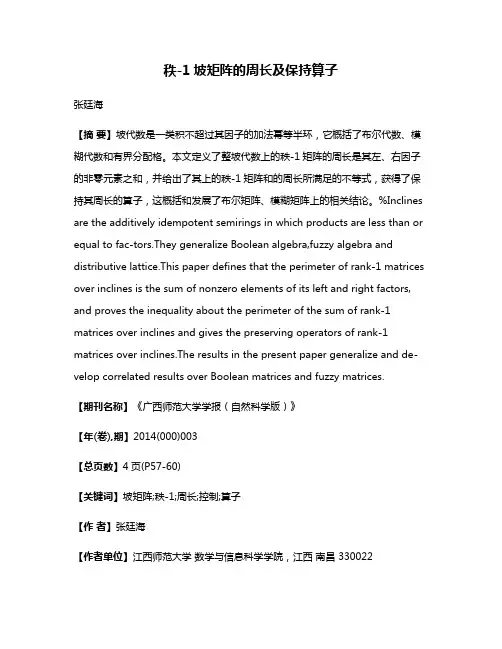
秩-1坡矩阵的周长及保持算子张廷海【摘要】坡代数是一类积不超过其因子的加法幂等半环,它概括了布尔代数、模糊代数和有界分配格。
本文定义了整坡代数上的秩-1矩阵的周长是其左、右因子的非零元素之和,并给出了其上的秩-1矩阵和的周长所满足的不等式,获得了保持其周长的算子,这概括和发展了布尔矩阵、模糊矩阵上的相关结论。
%Inclines are the additively idempotent semirings in which products are less than or equal to fac-tors.They generalize Boolean algebra,fuzzy algebra and distributive lattice.This paper defines that the perimeter of rank-1 matrices over inclines is the sum of nonzero elements of its left and right factors, and proves the inequality about the perimeter of the sum of rank-1 matrices over inclines and gives the preserving operators of rank-1 matrices over inclines.The results in the present paper generalize and de-velop correlated results over Boolean matrices and fuzzy matrices.【期刊名称】《广西师范大学学报(自然科学版)》【年(卷),期】2014(000)003【总页数】4页(P57-60)【关键词】坡矩阵;秩-1;周长;控制;算子【作者】张廷海【作者单位】江西师范大学数学与信息科学学院,江西南昌 330022【正文语种】中文【中图分类】O151.21自从20世纪80年代我国学者曹志强提出了坡代数和坡矩阵以来[1],有许多学者研究了有关坡代数和坡矩阵的各类性质及其应用。
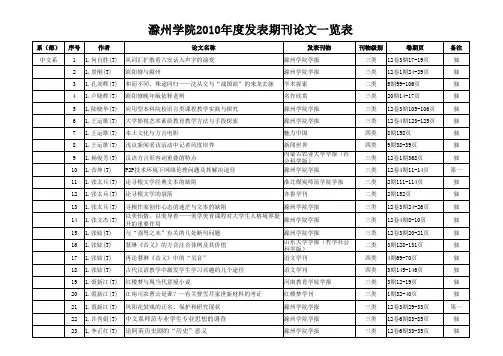
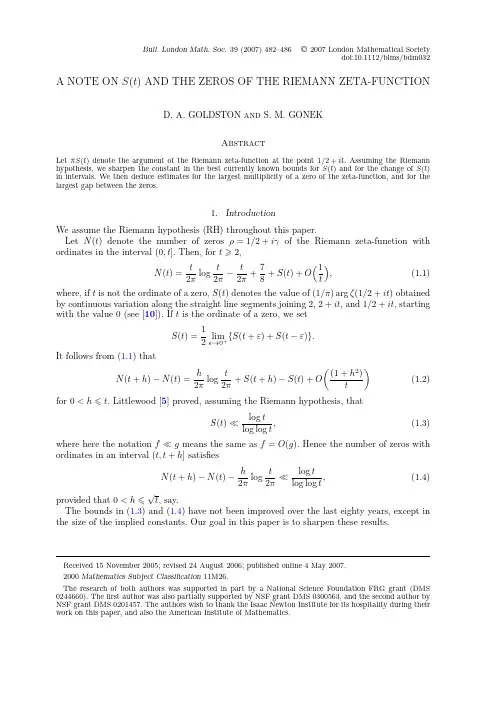
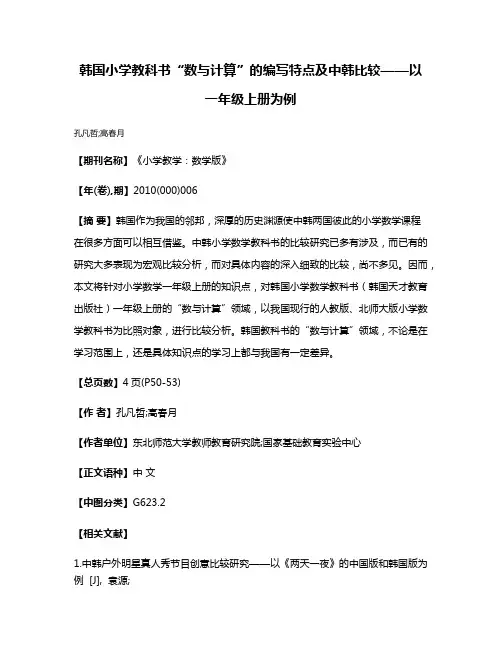
韩国小学教科书“数与计算”的编写特点及中韩比较——以
一年级上册为例
孔凡哲;高春月
【期刊名称】《小学教学:数学版》
【年(卷),期】2010(000)006
【摘要】韩国作为我国的邻邦,深厚的历史渊源使中韩两国彼此的小学数学课程
在很多方面可以相互借鉴。
中韩小学数学教科书的比较研究已多有涉及,而已有的研究大多表现为宏观比较分析,而对具体内容的深入细致的比较,尚不多见。
因而,本文将针对小学数学一年级上册的知识点,对韩国小学数学教科书(韩国天才教育出版社)一年级上册的“数与计算”领域,以我国现行的人教版、北师大版小学数学教科书为比照对象,进行比较分析。
韩国教科书的“数与计算”领域,不论是在学习范围上,还是具体知识点的学习上都与我国有一定差异。
【总页数】4页(P50-53)
【作者】孔凡哲;高春月
【作者单位】东北师范大学教师教育研究院;国家基础教育实验中心
【正文语种】中文
【中图分类】G623.2
【相关文献】
1.中韩户外明星真人秀节目创意比较研究——以《两天一夜》的中国版和韩国版为例 [J], 袁源;
2.中韩综艺节目的比较及启示——以湖南卫视和韩国MBC电视台为例 [J], 赵亮宇;
3.中韩信用证法律比较研究——以韩国新湖商社案与韩国国民银行案为例 [J], 曹伟峰
4.韩国小学教科书"数与计算"的编写特点及中韩比较——以一年级上册为例 [J], 孔凡哲; 高春月
5.中韩高校幼儿教师职前艺术教育课程设置及教学模式比较研究
——以遵义师范学院和韩国庆南大学为例 [J], 侯菲菲;郑国凤
因版权原因,仅展示原文概要,查看原文内容请购买。
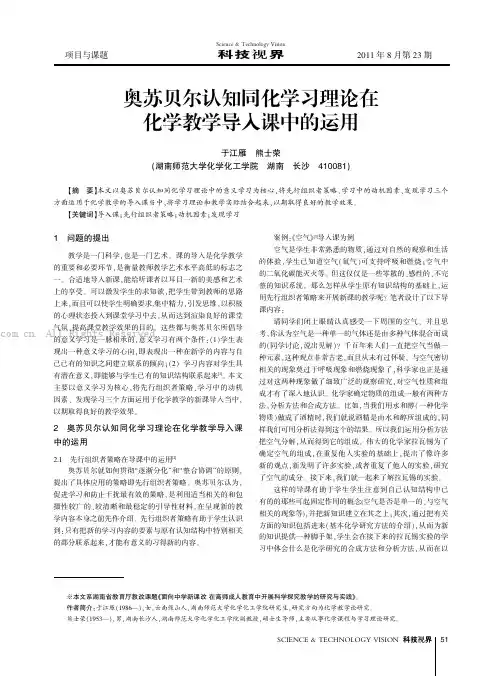
2011年8月第23期科技视界Science &Technology Vision※本文系湖南省教育厅教改课题《面向中学新课改在高师成人教育中开展科学探究教学的研究与实践》。
作者简介:于江雁(1986—),女,云南保山人,湖南师范大学化学化工学院研究生,研究方向为化学教学论研究。
熊士荣(1953—),男,湖南长沙人,湖南师范大学化学化工学院副教授,硕士生导师,主要从事化学课程与学习理论研究。
奥苏贝尔认知同化学习理论在化学教学导入课中的运用于江雁熊士荣(湖南师范大学化学化工学院湖南长沙410081)【摘要】本文以奥苏贝尔认知同化学习理论中的意义学习为核心,将先行组织者策略、学习中的动机因素、发现学习三个方面运用于化学教学的导入课当中,将学习理论和教学实际结合起来,以期取得良好的教学效果。
【关键词】导入课;先行组织者策略;动机因素;发现学习1问题的提出教学是一门科学,也是一门艺术。
课的导入是化学教学的重要和必要环节,是衡量教师教学艺术水平高低的标志之一。
合适地导入新课,能给听课者以耳目一新的美感和艺术上的享受。
可以激发学生的求知欲,把学生带到教师的思路上来,而且可以使学生明确要求,集中精力,引发思维,以积极的心理状态投入到课堂学习中去,从而达到渲染良好的课堂气氛、提高课堂教学效果的目的。
这些都与奥苏贝尔所倡导的意义学习是一脉相承的,意义学习有两个条件:(1)学生表现出一种意义学习的心向,即表现出一种在新学的内容与自己已有的知识之间建立联系的倾向;(2)学习内容对学生具有潜在意义,即能够与学生已有的知识结构联系起来[1]。
本文主要以意义学习为核心,将先行组织者策略、学习中的动机因素、发现学习三个方面运用于化学教学的新课导入当中,以期取得良好的教学效果。
2奥苏贝尔认知同化学习理论在化学教学导入课中的运用2.1先行组织者策略在导课中的运用[2]奥苏贝尔就如何贯彻“逐渐分化”和“整合协调”的原则,提出了具体应用的策略即先行组织者策略。
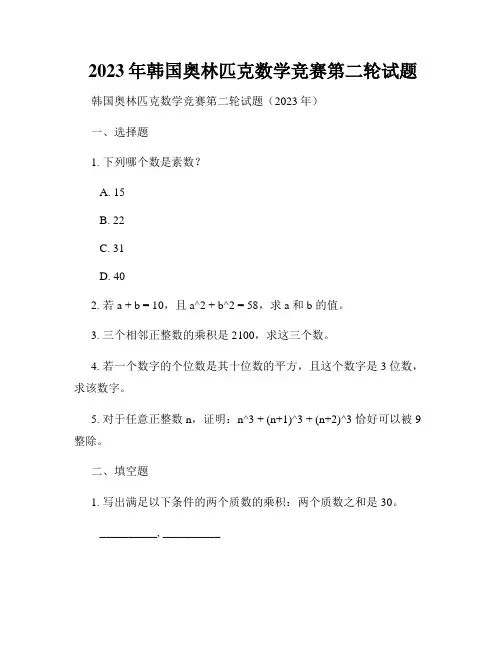
2023年韩国奥林匹克数学竞赛第二轮试题韩国奥林匹克数学竞赛第二轮试题(2023年)一、选择题1. 下列哪个数是素数?A. 15B. 22C. 31D. 402. 若 a + b = 10,且 a^2 + b^2 = 58,求 a 和 b 的值。
3. 三个相邻正整数的乘积是 2100,求这三个数。
4. 若一个数字的个位数是其十位数的平方,且这个数字是 3 位数,求该数字。
5. 对于任意正整数 n,证明:n^3 + (n+1)^3 + (n+2)^3 恰好可以被 9 整除。
二、填空题1. 写出满足以下条件的两个质数的乘积:两个质数之和是 30。
__________, __________2. 若 a + b = 15,且 a^3 + b^3 = 2915,则 a 和 b 的值分别为__________, __________。
3. 一个 4 位数,各位数字之和为 22,千位和百位数字相等,求该数。
4. 证明:1 + 2 + 3 + ... + n = n(n+1)/2(提示:使用数学归纳法)。
三、解答题1. 若点 A(x1, y1) 到点 B(4, -4) 的距离为 5,且点 A 在直线 y = 3x - 1 上,求点 A 的坐标。
2. 设数列 {an} 满足 a1 = 1,an+1 = 2an + 3。
求数列的通项公式。
3. 已知三角形 ABC,∠CAB = 45°,∠ABC = 75°。
设 O 是 AC 上的一点,且∠OBC = 15°。
求证:∠AOB = 120°。
4. 已知正整数 a,b,c 满足 a^2 + b^2 = c^2。
若 a,b,c 均为素数,求 a,b,c 的值。
四、解答题(含证明)1. 已知 a 和 b 是整数,且满足 a^2 - 3ab + 2b^2 = 0。
证明 a = b = 0。
2. 设函数 f(x) = (x + 1)(2x - 3) - (x - 2)(3x + 4),求函数 f(x) 的最小值。
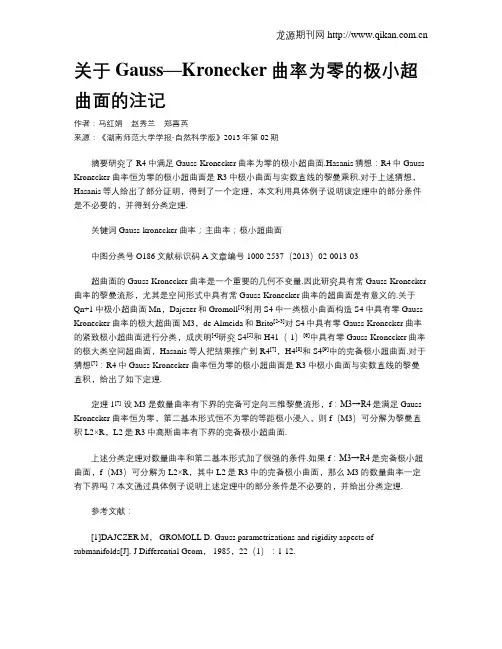
关于Gauss—Kronecker曲率为零的极小超曲面的注记作者:马红娟赵秀兰郑喜英来源:《湖南师范大学学报·自然科学版》2013年第02期摘要研究了R4中满足Gauss-Kronecker曲率为零的极小超曲面.Hasanis猜想:R4中Gauss-Kronecker曲率恒为零的极小超曲面是R3中极小曲面与实数直线的黎曼乘积.对于上述猜想,Hasanis等人给出了部分证明,得到了一个定理,本文利用具体例子说明该定理中的部分条件是不必要的,并得到分类定理.关键词Gauss-kronecker曲率;主曲率;极小超曲面中图分类号O186文献标识码A文章编号1000-2537(2013)02-0013-03超曲面的Gauss-Kronecker曲率是一个重要的几何不变量.因此研究具有常Gauss-Kronecker 曲率的黎曼流形,尤其是空间形式中具有常Gauss-Kronecker曲率的超曲面是有意义的.关于Qn+1中极小超曲面Mn,Dajczer和Gromoll[1]利用S4中一类极小曲面构造S4中具有零Gauss-Kronecker曲率的极大超曲面M3,de Almeida和Brito[2-3]对S4中具有零Gauss-Kronecker曲率的紧致极小超曲面进行分类,成庆明[4]研究S4[5]和H41(-1)[6]中具有零Gauss-Kronecker曲率的极大类空间超曲面,Hasanis等人把结果推广到R4[7],H4[8]和S4[9]中的完备极小超曲面.对于猜想[7]:R4中Gauss-Kronecker曲率恒为零的极小超曲面是R3中极小曲面与实数直线的黎曼直积,给出了如下定理.定理1[7]设M3是数量曲率有下界的完备可定向三维黎曼流形,f:M3→R4是满足Gauss-Kronecker曲率恒为零,第二基本形式恒不为零的等距极小浸入,则f(M3)可分解为黎曼直积L2×R,L2是R3中高斯曲率有下界的完备极小超曲面.上述分类定理对数量曲率和第二基本形式加了很强的条件.如果f:M3→R4是完备极小超曲面,f(M3)可分解为L2×R,其中L2是R3中的完备极小曲面,那么M3的数量曲率一定有下界吗?本文通过具体例子说明上述定理中的部分条件是不必要的,并给出分类定理.参考文献:[1]DAJCZER M, GROMOLL D. Gauss parametrizations and rigidity aspects of submanifolds[J]. J Differential Geom, 1985,22(1):1-12.[2]ALMEIDA S, BRITO F. Minimal hypersurfaces with constant Gauss-Kronecker curvature[J]. Math Z, 1987,195(8):99-107.[3]ALMEIDA S, BRITO F. Closed hypersurfaces of S4(1) with two constant symmetric curvature[J]. Ann Fac Sci Toulouse Math, 1997,6(6):187-202.[4]CHENG Q M, SUH Y J. Maximal space-like hypersurfaces in H41(-1) with zero Gauss-Kronecker curvature[J]. Korean Math Soc, 2006,43(1):147-157.[5]CHENG Q M. Hypersurfaces with constant quasi-Gauss-Kronecker curvature in S4(1)[J]. Adv in Math, 1993,22(2):125-132.[6]CHENG Q M. Complete space-like submanifolds in a de Sitter space with parallel mean curvature vector[J]. Math Z, 1991,206(3):333-339.[7]HASANIS T, SAVAS-HALILAJ A, VLACHOS T. Minimal hypersurfaces with zero Gauss-Kronecker curvature[J]. Ill J Math, 2005,49(2):523-529.[8]HASANIS T, SAVAS-HALILAJ A, VLACHOS T. Complete minimal hypersurfaces in the hyperbolic space H4 with vanishing Gauss-Kronecker curvature[J]. Trans Am Math Soc, 2007,359(6):2799-2818.[9]HASANIS T, SAVAS-HALILAJ A, VLACHOS T. Complete minimal hypersurfaces in S4 with zero Gauss-Kronecker curvature[J]. Math Proc Camb Philos Soc, 2007,142(1):125-132.[10]彭家贵,陈卿. 微分几何[M]. 北京:高等教育出版社, 2002.[11]忻元龙. 极小曲面的Bernstein型定理与Gauss映照的值分布[J]. 数学进展, 1989,18(4):402-411.[12]辛萍芳. 极小曲面的构造[J]. 湖北师范学院自然科学学报, 2002,22(4):31-34.[13]吴金文. 数量曲率刻划的球面中紧致极小子流形[J]. 湖南师范大学自然科学学报,2001,24(2):12-14.(编辑沈小玲)。
几类w-模的Krull-Remak-Schmidt定理张俊; 王芳贵【期刊名称】《《四川师范大学学报(自然科学版)》》【年(卷),期】2011(034)005【总页数】4页(P601-604)【关键词】w-模; 同态; Krull-Remak-Schmidt定理; 分解【作者】张俊; 王芳贵【作者单位】四川师范大学数学与软件科学学院四川成都610066; 四川师范大学外国语学院四川成都610101【正文语种】中文【中图分类】O154本文恒设R是具有单位元的交换环.整环上的w-算子理论[1]自1997年提出以来,受到了许多学者的广泛关注.这些研究使得它对环和模范畴的刻划上发挥了重要作用.最近,在文献[2]中,w-模的概念建立在一般交换环上.设R是交换环,J 是R的有限生成理想.如果自然同态R→HomR(J,R)是同构,则J称为R的GV-理想.令GV(R)是R的GV-理想的全体.设M是R-模,在文献[3]中定义了当gv.Tor(M)=0时,M称为 GV-无挠模;当gv.Tor(M)=M时,M称为GV-挠模.文献[2]还证明了模M是GV-无挠模当且仅当对R的任何GV-理想J,有HomR(R/J,M)=0.若M是GV-无挠模,且对R的任何GV-理想J,有Ext1R(R/J,M) =0,则称M是w-模.设M是GV-无挠模,令其中,E(M)是M的内射包.则Mw是E(M)中包含M的最小的w-模,称之为M的w-包络.关于交换环上w-模和w-算子的讨论,可以参见文献[2-6].模的直和分解是模理论中的一个重要问题.对于这一问题的讨论可以追溯到一百多年前,一个线性空间是否能分解为非平凡子空间的直和.J.H. M.Wedderburn、R.Remak、W.Krull和O.Schmidt等在这方面做了大量有意义的工作(可参见专著[7 -9]及其相关文献),使得模上也有了相应形式的表述,这就是Krull-Remak-Schmidt定理.设Mi,Nj是R-模,i=1,…,n,j=1,…,m,且M1⊕M2⊕…⊕Mn≅N1⊕N2⊕…⊕Nm.Krull-Remak-Schmidt定理说明若每一个EndRMi是局部环(未必是交换局部环),且每一个Nj是不可分解模,则m =n,且重排顺序后,有Mi≅Ni,i=1,…,n.本文依循这一思路,在Krull-Remak-Schmidt定理的观点下,讨论几类模直和分解的唯一性问题.在文献[4]中,介绍了w-单模的定义.设M是非零w-模,若M没有非平凡的w-子模,则M称为w-单模.w-半单模定义为w-单模的直和.类比Artin模的概念,设M是w-模,若M满足w-子模的降链条件,则称M是w-Artin模.在文献[6]基础上,进一步研究了具有w-子模链条件的模上的同态.当M是单模时,著名的Schur引理说EndRM是除环.对于w-单模,证明了Schur引理仍然成立.同时,本文证明了w-半单模,w-Noether环上非零的GV-无挠的内射模以及同时满足w-子模升链和降链条件的w-模可以唯一分解为自同态环是局部环的不可分解子模的直和.1 具有w-子模链条件的模上同态文献[6]将Orzech定理推广到了有限型w-模上.引理1.1 设M是有限型w-模,N是M的w -子模,f:N→M是w-满同态,则f是同构.推论1.2 设M是w-Noether模,f:M→M是w-满同态,则f是同构.对偶地,下面讨论w-Artin模上的同态.定理1.3 设M是w-Artin模,f:M→M是w -单同态,则f是同构.证明由于M是w-模,则f是单同态.于是对于任何正整数n,fn也是单同态.因此Im(f)⊇Im(f2)⊇…是M的w-子模降链.由于M是w-Artin模,故存在正整数k,使得Im(fk)=Im(fk+1).因此对于任何x∈M,存在y∈M,使得fk(x)= fk+1(y).从而有x=f(y),即有Im(f)=M.于是f还是满同态,故f是同构.推论1.4 若M既是w-Noether模也是w-Artin模,f:M→M是自同态,则以下3条等价:1)f是w-单同态;2)f是w-满同态;3)f是同构.引理1.5 设M是w-模,N是GV-无挠模,f:M→N是同态.则ker(f)是M的w-子模.证明设J∈GV(R),x∈M,Jx⊆ker(f).则f(Jx)=Jf(x)=0.由于N是GV-无挠模,则f(x) =0.因此,x∈ker(f).故ker(f)是M的w-子模.定理1.6 设f:M→M是自同态.则:1)若M是w-Artin模,则存在正整数k,使得对于任何正整数n≥k,M=(Im(fn)+ker(fn))w.2)若M是w-Noether模,则存在正整数k,使得对于任何正整数n≥k,0=Im(fn)∩ker(fn).证明 1)由M是w-Artin模,则存在正整数k,使得对于任何正整数n≥k,(Im(fn))w= (Im(f2n))w.任取x∈M,fn(x)∈ Im(fn)⊆(Im(fn))w=(Im(f2n))w,则存在J∈GV(R),使得Jfn(x)⊆Im(f2n),从而,对任何c∈J,cfn(x)∈Im(f2n),则存在y∈M,使得cfn(x)=f2n(y).于是,fn(cx-fn(y))=0,则cx∈Im(fn)+ker(fn).因此,Jx⊆Im(fn)+ker(fn).从而,x∈(Im(fn)+ ker(fn))w.故M=(Im(fn)+ker(fn))w.2)由引理1.5,ker(fn)与ker(f2n)都是M的w -子模.又M是w-Noether模,则存在正整数k,使得对于任何正整数n≥k,ker(fn)=ker(f2n).设x∈Im(fn)∩ker(fn),则存在y∈M,使得x=fn(y).从而,fn(x)=f2n(y)=0.于是,y∈ker(f2n)=ker(fn).故x=fn(y)=0.因此,0=Im(fn)∩ker(fn).Fitting引理是说若R-模M既是Noether模也是Artin模,则对M上任何一个自同态f,存在正整数k,使得对于任何正整数n≥k,有直和分解M=Im(fn)⊕ker(fn).这样同时满足子模升链和降链条件的模就可以表示为关于其自同态的直和分解.下面讨论w-模的Fitting引理.定理1.7(w-模的Fitting引理) 设R-模M既是w-Noether模也是w-Artin模,则对M上任何一个自同态f,存在正整数k,使得对于任何正整数n≥k,有直和分解令I=(Im(fn))w,K=ker(fn)是M的w-子模,则f限制在I上,即f|I是自同构;f限制在K上,即f|K是幂零自同态.证明由定理1.6,令正整数k取1)与2)中较大的那个,则存在正整数k,使得对于任何正整数n≥k,有M=(Im(fn))w⊕ker(fn).由f限制在I上,则有(f(I))w=I.于是,对于R的任何极大w-理想m,有fm:Im→Im是满同态,故f|I是I上的一个w-满同态.又显然I是M的既是w-Noether模也是w -Artin模的w-子模,由推论1.4,f|I是自同构.由f限制在 K上,则存在大于 k的正整数 n,使得(f|K)n=0,从而,f|K是幂零自同态.推论1.8 设R-模M既是w-Noether模也是w-Artin模,若M还是不可分解模,则M上任何一个自同态f,或者是自同构或者是幂零自同态.证明由定理1.7,有直和分解M=(Im(fn))w⊕ker(fn).又M还是不可分解模,则或者 M= (Im(fn))w,或者M=ker(fn).当 M=(Im(fn))w时,f是自同构;当M=ker(fn)时,f是幂零自同态.下面把关于单模的Schur引理推广到w-单模上.定理1.9 设M,N是R-模,f:M→N是非零同态.则:1)若M是w-单模,则f是单同态.2)若N是w-单模,则f是w-满同态.3)若M是w-单模,且g:M→M是非零自同态,则g是同构.4)若M是w-单模,则EndRM是除环.证明 1)由ker(f)是M的子模,(ker(f))w是M的w-子模,又M是w-单模,故(ker(f))w=0或(ker(f))w=M.由f是非零同态,则fm也是非零同态,故(ker(f))m≠Mm.因此,(ker(f))w≠M.从而,(ker(f))w=0,于是,f是单同态.2)由Im(f)是N的子模,(Im(f))w是N的w -子模,又N是w-单模,故(Im(f))w=0或(Im(f))w=N.由f是非零同态,则(Im(f))w=N,于是,对于任何极大w-理想m,Im(f)m=Nm.从而,f是w-满同态.3)由1)可知g是单同态.又由定理1.3,则g同构.4)由3)易知EndRM是除环.2 Krull-Remak-Schmidt定理引理2.1 (Krull-Remak-Schmidt定理)设Mi,Nj是R-模,i=1,…,n,j=1,…,m,且M1⊕M2⊕…⊕Mn≅N1⊕N2⊕…⊕Nm.若每一个EndRMi是局部环(未必是交换局部环),且每一个Nj是不可分解模,则m=n,且重排顺序后,有Mi≅Ni,i=1,…,n.证明参见文献[7]的推论7.3.5.定理2.2 设Mi,Nj是w-单模,i=1,…,n,j =1,…,m.且M1⊕M2⊕…⊕Mn≅N1⊕N2⊕…⊕Nm.则n=m,且重排顺序后,有Mi≅Ni,i=1,…,n.证明由定理1.9与引理2.1即得.以上定理说明,w-半单模的不可分解直和分解是唯一确定的.在文献[3]中证明了在w-Noether环上,每个GV-无挠的内射模都是不可分解的内射模的直和.下面讨论这样的直和分解是否在同构意义下唯一.定理2.3 设R是w-Noether环,M是GV-无挠的内射R-模,若M可以表示为其中Mi是不可分解内射模,i=1,2,…,n.若M还可以表示为其中Nj是不可分解内射模,j=1,2,…,m,则n=m,且重排顺序后,有Mi≅Ni,i=1,…,n.即 w-Noether环上GV-无挠的内射模的不可分解直和分解是唯一确定的.证明设E是模M的不可分解直和分解中任何一个直和加项,由文献[7]的定理7.2.8,则EndRE是局部环.由引理2.1,结论成立.定理2.4 设R-模M是w-Artin模,则存在M的有限个不可分解w-子模M1,M2,…,Mn,使得M=M1⊕M2⊕…⊕Mn.证明由M是w-Artin模,则M有关于w-子模的极小条件.令Γ={A|A是M的非零的直和加项}.由M≠0且M=M⊕0,有M∈Γ.于是,Γ非空.又M是w-模,设A∈Γ,则对任何J∈GV(R),R/J是有限表现模,则Ext1R(R/J,M)=Ext1R(R/J,A⊕M')=Ext1R(R/J,A)⊕Ext1R(R/J,M')=0.故Ext1R(R/J,A)=0.因此,A是w-模.即Γ作为M的非零的直和加项的集合,其中每一个元素都是M的w-子模.从而,Γ中有极小元,不妨记为A0.由A0的极小性,可知A0是不可分解的.设S={B|B是M的w-子模,且存在M的有限个不可分解w-子模B1,B2,…,Bm,使得M=B1⊕B2⊕…⊕Bm⊕B}.由于A0∈Γ,有M/A0∈S,即S非空.故S中有极小元.记为B0.于是,存在M的有限个不可分解w-子模M1,M2,…,Mn,使得M=M1⊕M2⊕…⊕Mn⊕B0.下面证明B0=0.假设B0≠0.由M是w-Artin模且B0是M的w-子模,故B0也是w-Artin模.从而,可知B0包含有一个非零的不可分解的直和加项,这与B0的极小性矛盾.因此,结论成立.类似地,对于w-Noether模而言,由关于w-子模的极大条件,可以证明:设M是w-Noether模,则存在M的有限个不可分解w-子模M1,M2,…,Mn,使得M=M1⊕M2⊕…⊕Mn.定理2.5 设R-模M是既是w-Noether模也是w-Artin模的不可分解模,则自同态环EndRM是局部环.证明由于M既是w-Noether模也是w-Artin模,故由定理1.7,对M上任何一个自同态f,存在正整数k,使得对于任何正整数n≥k,使得M=(Im(fn))w⊕ker(fn).又 M是不可分解模,则有(Im(fn))w=0或ker(fn)=0.若ker(fn)=0,则ker(f)⊆ker(fn)=0,即ker(f)=0.于是,f是单同态.由推论1.4,f同构.从而f可逆;若(Im(fn))w= 0,则Im(fn)=0,即有fn=0.于是,1=1-fn=(1-f)(1+f+…+fn-1).故对于任何f∈EndRM,有f可逆,或1-f可逆.由文献[7]的定理7.1.1,EndRM是局部环.定理2.6 设Mi是既是w-Noether模也是w -Artin模的不可分解R-模,i=1,2,…,n,Nj是不可分解w-模,j=1,2,…,m,且M1⊕M2⊕…⊕Mn≅N1⊕N2⊕…⊕Nm.则n=m,且重排顺序后,有Mi≅Ni,i=1,…,n.即既是w-Noether模也是w-Artin模的模的不可分解直和分解是唯一确定的.证明由定理2.4,定理2.5与引理2.1即得.致谢四川师范大学科研基金(定向研究) (10DXL02)对本文给予了支助,谨致谢意. 参考文献[1]Wang F G,McCasland R L.On w-modules over strong Mori domains [J].Commun Alge,1997,25:1285-1306.[2]Yin H Y,Wang F G,Zhu X S,et al.w-Modules over commutative rings[J].J Korean Math Soc,2011,48:207-222.[3]王芳贵,张俊.w-Noether环上的内射模[J].数学学报,2010,53(6):1119-1130.[4]王芳贵.星型算子理论的发展及其应用[J].四川师范大学学报:自然科学版,2009,32(2):249-259.[5]王芳贵.有限表现型模与w-凝聚环[J].四川师范大学学报:自然科学版,2010,33(1):1-9.[6]张俊,王芳贵.有零因子的交换环上w-理想的升链条件[J].四川师范大学学报:自然科学版,2010,33(2):146-151.[7]Kasch F.Modules and Rings[M].New York:Academic Press,1982. [8]Jacobson N.Basic Algebra II[M].San Francisco:W.H.Freeman and Company,1980.[9]贺昌亭,张同君.模论讲义[M].长春:东北师范大学出版社,1987. [10]Anderson F W,Fuller K R.Rings and Categories of Modules[M].New York:Springer-Verlag,1992.[11]王芳贵.交换环与星型算子理论[M].北京:科学出版社,2006.[12]陈晋键,陈顺卿.模论[M].开封:河南大学出版社,1994.[13]Wang F G,McCasland R L.On strong Mori domains[J].J Pure Appl Algebra,1999,135:155-165.[14]Matsumura mutative Ring Theory[M].Cambridge:Cambridge University Press,1986.[15]Kang B G.Integral closure of rings with zero divisors[J].J Algebra,2000,146:283-290.[16]Kurdachenko L A,Otal J,I Ya Subbotin.Artinian Modules over Group Rings[M].Basel:Birkhäuser,2007.[17]宋光天.交换代数导引[M].合肥:中国科学技术大学出版社,2002. [18]Kim H.Module-theoretic characterizations of t-linkative domains [J].Commun Alge,2008,36:1649-1670.[19]Wang F G.w-modules over a PVMD[C]//Proceedings of the International Symposium on Teaching and Applications of Engineering Mathematics.Hong Kong,2001:117-120.[20]Wang F G.On w-projective modules and w-flat modules[J].Algebra Colloq,1997,4:112-120.[21]Baghdadi S E L,Gabelli S.w-divisorial domains[J].J Pure Appl Algebra,2005,285:335-355.。
数学杂志是数学家交流学术的主要阵地.一切数学成果可以在学术会上报告,通过新闻报导和信件交流得以传播,但是最终必须在专业杂志上发表才算正式得到确认。
即使现在已经出现了一些电子杂志,如美国数学会出版的《电子研究公报》(Electronic Research Announcements),不过人们还是觉得白纸黑字的印刷方式最具权威性.19世纪能够发表数学论文的杂志有950种,但专门的数学杂志术过几十种,真正重要的就更少.大多集中在欧洲,尤以英、德、法、意诸国的数学杂志较为著名,一个国家也就是一两份.进入20世纪,职业数学家的人数大为增加,分工日益精细,除统一的数学杂志以外,还出版几何、代数、微分方程、逻辑、泛函分析、组合数学等许多专业性更强的杂志.到20世纪末年,世界数学杂志的数目已经无法精确统计.美国《数学评论》评论的数学杂志数目达到4000余种.日本的《岩波数学辞典》(中译名为《数学百科辞典》,科学出版社出版)是目前国际通用的数学辞典,其中收录的名家著作,出自254种数学杂志和丛书.数学家把自己认为重要的数学论文投寄一些国际上最著名的数学杂志.哪些杂志是“著名”的,或者“高质量”的呢?这没有明确的界定.依通常的印象,也许以下几种有特殊的重要性:《数学学报》(Acta Mathematica)(瑞典乌普萨拉),1882年创刊。
《纯粹数学与应用数学杂志》(Journal fur die Reine und Angwandte Mathematik)(柏林),由克雷尔(August leopold Crelle,1780~1855)于1826年创办,俗称克雷尔杂志。
《数学年刊》(Mathematische Annalen) (柏林-格丁根-海得尔贝格)。
《伦敦数学会杂志》(The Journal of Lundon Mathematical Society)(伦敦),1865年创刊。
《剑桥哲学会进展》(Proceedings of the Cambridge PhilosophicalSociety)(英国剑桥)。
Wirtinger不等式的一个几何应用赵亮;马磊;周家足【摘要】In this article, we investigate the known Minkowski inequality for mixed area1 of two convex sets. By using the well-known Wirtinger inequality, we obtain a simplified proof of the Minkowski inequality for the mixed area of two convex sets.%本文研究了著名的Minkowski混合面积不等式.利用平面凸集的支持函数的性质和分析中著名的Wirtinger不等式,得到了Minkowski混合面积不等式的一个简化证明.【期刊名称】《数学杂志》【年(卷),期】2011(031)005【总页数】4页(P887-890)【关键词】Minkowski混合面积;凸集;等周不等式;支持函数;Wirtinger不等式【作者】赵亮;马磊;周家足【作者单位】西南大学数学与统计学院,重庆400715;广东石油化工学院高州师范学院,广东广州525200;西南大学数学与统计学院,重庆400715【正文语种】中文【中图分类】O186.5最著名的几何不等式是经典的等周不等式:平面上固定周长的简单闭曲线中,圆所围成的面积最大.即平面上面积固定的区域中,圆盘的周长最小.等周不等式平面上域D的面积A,周长L满足L2−4πA≥0,等号成立当且仅当D为圆盘.等周不等式及与之相关的Bonnesen型不等式和Bottema不等式已被许多著名数学家多次给出不同的精彩证明(参见文献[2,4–6,8–14]).用积分几何思想和方法给出等周不等式及与之相关的一系列Bonnesen型不等式的系统证明是周家足(参见文献[4,6,11,12]).Santalo用关于R2中的凸集Ki,Kj的混合面积的Minkowski不等式证明了等周不等式[3].本文用平面凸集的支持函数的性质和分析中著名的Wirtinger不等式给出了Minkowski混合面积不等式的一个简化证明,进而得到了经典的等周不等式.若C为凸闭曲线,设C的支持函数为p=p(θ),则等号成立当且仅当存在常数a,b使得f(t)=acost+bsint.不等式(3.1)称为Wirtinger不等式(参见文献[5]).因此由Minkowski不等式(3.2)式,得到等周不等式.推论设K 为R2中的凸集,其周长和面积分别为L,A,则有L2−4πA≥0,等号成立当且仅当K为圆.【相关文献】[1]Chern S S.Curves and surfaces in euclidean space,global di ff erentialgeometry[M].Washington,D.C:MAA Studies in Mathematics,1989,99–139.[2]任德麟.积分几何学引论[M].上海:上海科学技术出版社,1988.[3]Santalo L.Integral geometry and geometric probability[M].New York:Addison Wesley Publishing Company,1976.[4]周家足.平面Bonnesen型不等式[J].数学学报,2006,50(6):1397–1402.[5]Osserman R.The isoperimetric inequality[J].Amer.Math.Soc.,1978,84(6):1183–1186.[6]周家足.积分几何与等周不等式[J].贵州师范大学学报(自然科学版),2002,20(2):1–3.[7]Flanders H.A proof of Minkowski’s inequality for convexcurves[J].Amer.Math.Monthly,1968,581–593.[8]Burago Y,Zalgaller V.Geometric inequalities[M].Berlin:Springer-Verlag,1988.[9]Grinberg E,Li Shougui,Zhang Gaoyong,Zhou Jiazu.Integral geometry andconvexity[C].Singapore:World Scienti fi c,2006.[10]项武义.等周问题的一个初等证明[J].数学年刊A辑(中文版),2002,23(1):8–11.[11]Li Ming,Zhou Jiazu.An isoperimetric de fi cit upper bound of the convex domain in a surface of constant curvature[J].Sci.China Math.,2010,53(8):1941–1946.[12]Zhou Jiazu,Xia Yunwei,Zeng Chunna.Some new Bonnesen-style inequalities[J].J.Korean Math.Soc.,2011,48(2):421–430.[13]何刚.等周不等式与Bol-Fujiwara定理[J].数学杂志,2006,26(3):309–311.[14]周家足,任德麟.从积分几何的观点看几何不等式[J].数学物理学报,2010,30A(5):1322–1339.。
抛物型交换四元数矩阵的性质及其逆矩阵求法孔祥强【摘要】以抛物型交换四元数及其矩阵的概念为基础,首先,利用矩阵的计算理论得到了抛物型交换四元数及其实表示的系列性质.其次,推导了抛物型交换四元数矩阵的性质,通过引入矩阵的实表示形式,得到求抛物型交换四元数矩阵逆矩阵的新方法,为进一步研究抛物型交换四元数矩阵的其余问题提供了理论支撑.最后,通过数值例子验证了结论的有效性和正确性.【期刊名称】《纯粹数学与应用数学》【年(卷),期】2018(034)002【总页数】12页(P183-194)【关键词】抛物型交换四元数矩阵;实表示;逆矩阵;性质【作者】孔祥强【作者单位】菏泽学院数学与统计学院,山东菏泽274015【正文语种】中文【中图分类】O151.11 引言四元数量子力学是现代量子力学的重要分支,它是建立在非交换的四元数代数上的量子力学,与一般的复量子力学不同,其相应粒子的波函数及其振幅是由四元数来表示.1849年,James Cockle提出了非交换的分裂四元数,其形式为:且满足分裂四元数代数H不是除环,且含有零因子、幂零元和幂等元[1-4].对分裂四元数的研究得到了系列成果,见文献[5-6]等.文献[7]中首次研究了乘法满足交换性的新代数系统,即由交换四元数构成的系统,该系统和分裂四元数系统一样也是四维代数系统,但交换四元数代数含有零因子和同位元.近年来,对交换四元数代数理论的研究逐步引起学者们的重视,且研究成果在数学和物理学等学科中均有很好的应用[8-10],因此对交换四元数理论的研究显得十分必要.文献[11]介绍了交换四元数的分类情况,具体包括椭圆型交换四元数、抛物型交换四元数和双曲型交换四元数等,但对每一类交换四元数并没有做深入研究.文献[12]研究了椭圆型交换四元数及其矩阵,得到此类交换四元数的性质,给出了此类交换四元数矩阵的复表示形式.相比较而言,学者对抛物型交换四元数和双曲型交换四元数的研究很少.与文献[12]不同,本文研究的是抛物型交换四元数及其矩阵,利用矩阵的实表示,得到此类交换四元数及其矩阵的重要性质,并给出了求抛物型交换四元数矩阵逆矩阵的新方法,且该方法可通过计算机得以轻松实现.在本文结果的基础上,可进一步深入探讨抛物型交换四元数矩阵的特征值问题、可对角化问题、行列式问题、盖尔圆盘定理的推广问题等;在本文思路的基础上,还可展开对双曲型交换四元数及其矩阵的深入研究.2 抛物型交换四元数设R为实数域,且满足称满足条件的四元数a为抛物型交换四元数[11].若ai=bi(i=0,1,2,3),称a与b相等.定义加法和乘法如下:抛物型交换四元数的共轭分三种形式,分别记为:则性质 2.1设a,b∈HR,s∈R,则(1)si=is;sj=js;sk=ks;(2)a=a(1)⇔a∈C;C为复数域;(3)ab=ba.证明由乘法定义知(1)成立.(2)由则(3)因故3 抛物型交换四元数的实表示定理 3.1任何一个抛物型交换四元数都可以表示成实数域上的4阶矩阵. 证明设定义映射则映射为双射且由此映射,可定义抛物型交换四元数集合为4×4实矩阵集合:的子集合,HR和M4×4(R)本质是相同的.故对抛物型交换四元数的研究可转化为R 上4×4矩阵的研究.R上4×4矩阵的性质即为HR上抛物型交换四元数的性质.称为a的实表示,记为aR.性质 3.1 设a,b∈HR,ξ1,ξ2∈R,tr(aR)为aR的迹,则(1)(ab)R=aRbR;(2)(ξ1a+ ξ2b)R= ξ1aR+ ξ2bR;(3)tr(aR)=a+a(1)+a(2)+a(3). 证明 (1)则故(2)与(1)中类似的方法可得特别地,当ξ1=ξ2=1时,(3)由共轭及实表示定义4 抛物型交换四元数矩阵及其性质设称A为一般的抛物型交换四元数矩阵.Ā表示A的共轭,AT表示A的转置,AH表示A的共轭转置.Mn×n(C)表示n阶复矩阵集合.对于B∈Mn×s(HR),a,b∈HR,有若则称A为可逆矩阵,且性质 4.1 设A,B∈Mn×n(HR),则(1)(AB)T=BTAT;(2)若A,B 均可逆,则(AB)−1=B−1A−1;(3)(AB)H=BHAH.证明设其中(1)(2)由故 AB 可逆,且(AB)−1=B−1A−1.(3)对A∈Mm×n(HR)而言,其共轭矩阵有三种形式:要证的结论即为:① (AB)H=(B′)T(A′)T; ② (AB)H=(B′′)T(A′′)T; ③ (AB)H=(B′′′)T(A′′′)T.证明如下:①故故③故5 抛物型交换四元数矩阵的逆矩阵定理 5.1 设A,B∈Mn×n(HR),且满足BA=In,则AB=In.证明因为则故即则所以又则设定义A的实表示矩阵为:记为AR.则Mn×n(HR)和M4n×4n(R)本质上是相同的,故对抛物型交换四元数矩阵的研究可转化为R上4n×4n矩阵的研究.R上4n×4n矩阵的性质即为HR上抛物型交换四元数矩阵的性质.性质 5.1 设A,B∈Mn×n(HR),则(1)InR=I4n;(2)(A+B)R=AR+BR;(3)(AB)R=ARBR;(4)若 A 可逆,则(A−1)R=(AR)−1.证明 (1)由取由实表示的定义,InR=I4n.(2)由则(3)利用与(2)类似的方法证得,(4)由A−1存在,则故所以定理 5.2 设A∈Mn×n(HR),AR可逆,且(AR)−1∈M4n×4n(R),则 A 可逆. 证明由则由于取则由定理5.1知,则注 5.1定理5.2给出了求抛物型交换四元数矩阵A的逆矩阵的方法.具体可总结为以下几步:①写出A的实表示AR;②求出AR的逆矩阵(AR)−1;③令则该方法使得利用计算机求抛物型交换四元数矩阵的逆矩阵成为可能.6 算例设则求得所以故经检验所得结论正确.7 结语本文推导了抛物型交换四元数及其矩阵的重要性质;通过抛物型交换四元数矩阵的实表示,得到求该类矩阵逆矩阵的新方法,为进一步研究抛物型交换四元数矩阵的行列式问题、可对角化问题,及特征值等问题提供了重要理论支撑.对交换四元数及交换四元数矩阵的研究已逐渐成为四元数研究领域的热点问题.另外,在本文的基础上,还可展开对其他类型交换四元数及其矩阵性质的研究.参考文献[1]Alagoz Y,Oral K H,Yuce S.Split quaternion matrices[J].MiskolcMath.Notes,2012,13(2):223-232.[2]Pogoruy A,Rodriguez Dagnino R M.Some algebraic and analytical properties of coquaternion algebra[J].Adv.Appl.Cli ff ordAlgebra,2010,20(1):79-84.[3]Ozdemir M.The roots of splitquaternion[J].Appl.Math.Lette.,2009,22(2):258-263.[4]Kula L,Yayli Y.Split quaternions and rotations in semi Euclideanspace[J].J.Korean Math.Soc.,2007,44(6):1313-1327.[5]Ozdemir M.On complex split quqternion matrices[J].Adv.Appl.Cli ff ord Algebra,2013,23(3):625-638.[6]Ozdemir M.On eigenvalues of split quaternion matrix[J].Adv.Appl.Cli ff ord Algebra,2013,23(3):615-623.[7]Segre C.The real representations of complex elements and extension to bicomplex systems[J].Math.Ann.,1892,40:413-467.[8]Pinotsis D A.Segre Quaternions,Spectral Analysis and a Four-Dimensional Laplace Equation,in Progress in Analysis and ItsApplications[M].Singapore:World Scienti fic,2010.[9]Catoni F,Cannata R,Nichelatti E,et mutative hypercomplex numbers and functions of hypercomplex variable:a matrixstudy[J].Adv.Appl.Cli ff ord Algebra,2005,15(2):183-213.[10]Pei Soochang,Chang Jahan,Ding mutative reduced biquaternions and their fourier transform for signal and image processing applications[J].IEEE Transactions on Sinal Processing,2004,52(7):2012-2031.[11]Catoni F,Cannata R,Zampetti P.An introduction to commutative quaternions[J].Adv.Appl.Cli ff ord Algebra,2006,16(1):1-28.[12]Kosal H H,Tosun mutative quaternion matrices[J].Adv.Appl.Cli ff ord Algebra,2014,16(3):769-799.。
河北工业大学教工优秀共产党员标兵候选人事迹材料教学之星候选人一、马苓,女,回族,1978年2月出生,2001年7月参加工作,现为经济管理学院副教授。
主要事迹:2010-2012年,连续三年获“课堂教学质量优秀奖”;2012年,获“校级优秀任课教师”称号。
2009-2011年,主持结项校级重点教改项目2项。
2012年,第一作者两篇教研论文获河北省优秀高等教育科研成果二等奖。
2011-2013年,指导3名本科生获校级优秀毕业论文。
发表教研论文3篇,其中1篇EI索引,1篇ISSHP索引。
二、王宝林,女,汉族,1976年9月出生,2008年10月参加工作,现任马克思主义学院教研室主任,副教授。
主要事迹:讲授专业课程《政治学》《科学社会主义》,本科生公共课1门,研究生公共课2门,获本科和研究生课堂教学质量奖;指导2人次获校级优秀毕业论文;近两年主持省部级课题4项,参与3项,主持厅局级课题4项,发表核心论文3篇、一般11篇;获1项省级教学成果二等奖,1项校级教学成果一等奖;任学术研究导师,获1项校级、1项国家级创新项目,指导学生发表学术论文近10篇;指导学生暑期、寒假社会实践活动,获“三下乡”先进个人,指导学生获“调研河北”课题立项,组织学生为灾区捐款捐物等。
校群众路线教育实践活动宣讲团成员,讲解十八届三中全会内容,为河北省选学干部做“关于社会政治发展形势”专题报告。
三、王洪海,男,汉族,1974年4月出生,1997年7月参加工作,现任化工学院教研室主任,副教授。
主要事迹:2012年获得国家科技进步二等奖1项、2013年指导学生参加“全国大学生化工设计竞赛”荣获全国一等奖1项、2013年主编出版《化工原理》教材1部、主持教育厅重点研究项目1项、主研国家青年基金1项、主持有资金支持的校级教研项目1项并结题,获得2次课堂教学质量优秀奖、2010-至今连续2次获得校级优秀教师称号、多次获得校级优秀党员称号、以第一作者在化工类工程教育典型期刊《化工高等教育》发表教学论文2篇、在国际化工类典型期刊CET上发表科研论文1篇,其他三大检索论文2篇。
推荐(必需、推荐1、推荐2、推isbn书名中文译名作者出版日期出版社Kirkwood, Jam数学物理学与偏2012Academic PresMathematical余用江 史仁坤-推荐19780123869111实分析课程Mcdonald, Joh2012Academic PresA Course In R史仁坤-推荐297801238777412012Oxford UniverLopes, Helena不可压缩流动的余用江 史仁坤9780198528548MathematicalCarlo Berzuin因果性-统计观2012-05WileyCausality - S吴耀琨9780470665565George Dassio2012Cambridge Uni椭球谐波:理论Ellipsoidal H史仁坤-推荐29780521113090Edited by Luc代数几何最新趋2012-04Cambridge UniCurrent Devel张月辉-推荐9780521768252Mark Levi2012-04Princeton Uni为什么猫安全着Why Cats Land麻志浩97806911485402012-03Princeton Uni数值方法Anne Greenbau汤洪阳9780691151229Numerical Met2012-02Princeton UniAmy N. Langvi谁是第一?评定麻志浩9780691154220Who''s #1? :2012Birkhäuser BoRinaldo B. Sc史仁坤-推荐19780817682880从微积分到分析From CalculusLacra Pavel2012Birkhäuser Bo光网络控制的博Game Theory f吴耀琨9780817683214Carlos S. Kub2012Birkhäuser BoHilbert空间算余用江-推荐1Spectral Theo史仁坤9780817683276Joaquin Perez几何分析:偏微2012-06American MathGeometric Ana余用江-推荐1史仁坤97808218499272012-05American Math热势理论导论(Neil A. WatsoIntroduction史仁坤-推荐19780821849989余用江-推荐12012-04American MathDominic JoyceA Theory of G广义唐纳森 -张月辉-推荐97808218527982012-01American MathEdited by P.New Trends In非交换代数新趋张月辉-推荐9780821852972Victor Goryun实奇点与复奇点2012-06American MathReal and Comp余用江-推荐1史仁坤-推荐197808218535972012-05American MathAntonio CampiZeta Function代数和几何中的张月辉-推荐9780821869000调和分析:从傅2012-06American MathMaria CristinHarmonic Anal余用江 史仁坤9780821875667A. B. Sossins几何学(丛书)2012-06American MathGeometries (史仁坤-推荐29780821875711Pascal Cherri2012-08American Math希尔伯特空间中Linear and Qu余用江 史仁坤9780821875766Graham J. LeuCohen-Macaula2012-06American MathCohen-Macaula张月辉9780821875810Loo-Keng Hua2012Cambridge Uni高等数学导论(Introduction史仁坤-推荐29781107020016Geometric Ana几何分析Peter Li2012Cambridge Uni 史仁坤-推荐29781107020641余用江-推荐1概率学者的偏微2012Cambridge UniDaniel W. StrPartial Diffe史仁坤-推荐19781107400528孤子(丛书)T. Miwa2012-04Cambridge Uni 史仁坤-推荐19781107404199Solitons : Di2012Cambridge Uni真实分析讲座Finnur LárussLectures on R余用江 史仁坤-推荐29781107608528边界条件下得偏J. L. Synge2012Cambridge UniThe Hypercirc史仁坤-推荐29781107666559J. J. Thomson2012Cambridge UniJames Clerk M詹姆斯·克拉克史仁坤-推荐29781107670952微积分,国际研Howard Anton2012WileyCalculus, 10T史仁坤-推荐29781118092484常微分方程Greenberg2012John Wiley汤洪阳9781118230022Ordinary Diff2012WH Freeman适量微积分Jerrold E. MaVector Calcul史仁坤-推荐29781429224048Sasho Kalajdz2012Taylor & Fran一本图文并茂的An Illustrate吴耀琨9781439848159David Jerison现代数学的发展2012InternationalCurrent Devel史仁坤-推荐19781571462282Zoltán ádám M线性规划-理论2012-02Nova ScienceLinear Progra吴耀琨9781612095790Edited by Lyn2012Curran Associ2011 第29届系29th Internat史仁坤-推荐29781618392299Inequality ThCho, Yeol Je2012-02Nova Science不等式理论与应9781621008491麻志浩 余用江-推荐1史仁坤-推荐2012-02Alpha Science统计算法Rajan ChattamStatistical A吴耀琨9781842657270Rafael Ayala2012-02Alpha Science代数拓扑学:导Algebraic Top吴耀琨9781842657362Erwan Faou (E2012-01European Math几何数值积分和Geometric Num史仁坤-推荐29783037191002B?rm, Steffen特征值问题的数2012-05de GruyterNumerical Met汤洪阳9783110250336Edited by Sat交换代数进展2012-03de GruyterProgress in C张月辉9783110250343线性与半线性偏Precup, Radu2012-05de GruyterLinear and Se史仁坤-推荐29783110269048余用江-推荐12012-05de Gruyter分布:索伯列夫BhattacharyyaDistributions史仁坤-推荐19783110269277余用江-推荐12012-05de GruyterGodet-Thobie,Young Measure测量空间中的新史仁坤-推荐19783110276404拓扑分析:从基V?th, Martin2012-05de GruyterTopological A余用江-推荐19783110277227Edited by Sat2012-03de Gruyter交换代数进展Progress in C张月辉9783110278590Edited by Giu2012-02Edizioni dellTopics in Mod现代正则性理论余用江 史仁坤-推荐197888764242672012Atlantis PresRamachandran,随机微分方程的史仁坤-推荐29789491216466Stochastic DiHibi Takayuki2012World ScientiGRÖBNER基与现Harmony Of Gr吴耀琨9789814383455Xue Yifeng2012World Scienti算子的稳定扰动史仁坤9789814383592Stable Pertur语言模式的数学Blasi Damian 2012World ScientiMathematical吴耀琨97898143836912012-05World ScientiSinai Yakov E沃尔夫数学奖余用江-推荐19789814390279Wolf Prize InSinai Yakov E2012-05World ScientiWolf Prize In沃尔夫数学奖余用江-推荐19789814390293Chua Leon O2012World ScientiWOLFRAM新学科余用江-推荐19789814390514Nonlinear DynMiller J J H 2012World Scienti奇异摄动问题的Fitted Numeri余用江-推荐19789814390736classno版本卷次币制价格副标题编者页数装帧O1USD89.95432Hardback O1USD134.95688Hardback O1Hardback O1USD90384ClothO1USD110Theory and Applications390Hardback O1USD90428Hardback O1USD18.95240Paperback O1USD95464ClothO1USD29.95266ClothO1EUR54.95250Hardback O1EUR84.95265Hardback O1EUR49.95200Hardback O1USD74191Softcover O1USD86266Hardcover O1USD86199Softcover O1USD99297Paperback O1USD74202Softcover O1USD108347Softcover O1USD58411Softcover O1USD48301Softcover O1USD75378Hardcover O1USD96367Hardcover O18USD200900Hardback O1USD75415Hardback O18USD29.99232Paperback O1USD35118Paperback O1USD39.99130Paperback O1USD76.99A Method for the Approx436Paperback N9USD35A Commemoration Volume 156Paperback O1USD86.95Paperback O1USD114.95544Hardback O1GBP60.99676Hardback O1GBP57.99500Hardback O1USD48182Hardback O1USD89389Hardcover N94USD2954312Softcover O1USD89323Paperback O1GBP29.95304Hardcover O1GBP49.95385Hardcover O1EUR32146Paperback O1EUR29.95190Paperback O1EUR129.95300Hardcover O1EUR49.95290Paperback O1EUR69.95575Paperback O1EUR119.95350Hardcover O1EUR119.95450Hardcover O1EUR129.95300Hardcover O1EUR25200Softcover O1EUR79.95248Hardback O1USD180The Second Crest-Sbm In500Hardback O1USD98300Hardback O1USD94Organization And Evolut250Hardback O1USD188600Hardcover O1USD182580Hardcover N80USD158350HardbackO1USD68Error Estimates In The 192Hardback主题词丛书名描述附件精简装对照语种Mathematical Physics with Partial Differential Equations is for advanced undeThe second edition of A Course in Real Analysis provides a solid foundation oFocussing on the mathematical theory of viscous compressible fluids, this text for gra Time Series Collating a broad collection on co EnglishThe sphere is what might be called a perfect shape. Unfortunately nature is i EncyclopediaMathematics-Topology an Algebraic geometry is one of the m EnglishMathematics Ever wonder why cats land on their EnglishMathematics Numerical Methods provides a clear EnglishMathematics A website''s ranking on Google can EnglishThis comprehensive textbook is intended for a two-semester sequence in analysis. The f Static & DynaOptical networks epitomize complex communication systems, and they comprise tThis work is a concise introduction to spectral theory of Hilbert space operators. Its Math This volume contains research and EnglishMath This book is the first to be devot EnglishMath This book studies generalized Dona EnglishMATHEMATICS / General EnglishMath This volume is a collection of pap EnglishMath The volume contains the proceeding EnglishMath In the last 200 years, harmonic an EnglishMath The book is an innovative modern e EnglishMath This book considers evolution equa EnglishMath This book is a comprehensive treat EnglishThe self-taught mathematician Hua Loo-Keng (1910–1985) spent most of his wor The CambridgeThe aim of this graduate-level text is to equip the reader with the basic too Cambridge StuThis book deals with equations that have played a central role in the interpl Cambridge StuMathematics-Topology an This book was first published in 2EnglishThis is a rigorous introduction to real analysis for undergraduate students, Australian MaOriginally published in 1957, this book was written to provide physicists and engineerOriginally published in 1931, this volume was created to mark the centenary of James CThe new edition of Calculus continues to bring together the best of both new and tradiAfter a brief review of first-order differential equations, this book focuses on seconThis textbook by respected authors helps students foster computational skills and intuThis text explores the beauty of topology and homotopy theory in a direct, engaging, aPapers based on selected lectures given at the Current Development Mathematics Confere Mathematics At the crossroads of mathematics, EnglishElectrical & Computer E Sponsor: System Dynamics SocietyEnglishMathematics This book introduces and exchanges EnglishMathematics STATISTICAL ALGORITHMS integrates EnglishMathematics ALGEBRAIC TOPOLOGY: An Introductio EnglishMath The goal of geometric numerical in EnglishMathematics Eigenvalues and eigenvectors of ma EnglishMathematics This is the first of two volumes o EnglishMathematics The text is intended for students EnglishMathematics This textbook is addressed to the EnglishMathematics In recent years, technological pro EnglishMathematics This monograph aims to give a self EnglishMathematics This is the second of two volumes EnglishPartial Differential Eq This book contains lecture notes o EnglishThe subject theory is important in finance, economics, investment strategies, Atlantis StudThis volume consists of research papers and expository survey articles presented by thThis book provides a broad introduction to the generalized inverses, Moore–Penrose inThe Mathematical Structure of Language Patterns provides a comprehensive comp World ScientiMathematics-Geometry & This invaluable book features bibl EnglishMathematics-Geometry & This invaluable book features bibl EnglishWhen not immersed in science, he relaxes by searching for Wagner's leitmotifs World ScientiSince the first edition of this book, the literature on fitted mesh methods fundergraduate and beginning graduate students taking a course on mathematical physics taught out of mion of real analysis concepts and principles, presenting a broad range of topics in a clear and concisuids, this text for graduates and researchers in applied mathematics develops the most recent ideas and concepts in the ly nature is imperfect and many bodies are better represented by an ellipsoid. The theory of ellipsoidal harmonics, orience in analysis. The first four chapters present a practical introduction to analysis by using the tools and concepts hey comprise the Internet’s infrastructural backbone. The first of its kind, this book develops the mathematical frame rt space operators. Its emphasis is on recent aspects of theory and detailed proofs, with the primary goal of offering ost of his working life in China and suffered at first hand the turbulence of twentieth-century Chinese politics. His i the basic tools and techniques needed for research in various areas of geometric analysis. Throughout, the main theme in the interplay between partial differential equations and probability theory. Most of this material has been treated ate students, starting from the axioms for a complete ordered field and a little set theory. The book avoids any precon physicists and engineers with a means of solving partial differential equations subject to boundary conditions. The tex he centenary of James Clerk Maxwell's birth. Comprised of ten essays dealing with various aspects of Maxwell's life and t of both new and traditional curricula in an effort to meet the needs of even more instructors teaching calculus. The s book focuses on second-order equations with constant coefficients that derive their general solution using only resul ational skills and intuitive understanding with a careful balance of theory, applications, historical development and o n a direct, engaging, and accessible manner while illustrating the power of the theory through many, often surprising, ent Mathematics Conference, held in November 2010 at Harvard University.</p>nt strategies, health sciences, environment, industrial engineering, etc.rticles presented by the invited speakers of the conference on “Harmony of Gröbner Bases and the Modern Industrial Soc rses, Moore–Penrose inverses, Drazin inverses and T–S outer generalized inverses and their perturbation analyses in t rehensive compilation, description, and discussion of recent advancements on quantitative linguistics carried out from r's leitmotifs, musing over Kandinsky's chaos, and contemplating Wittgenstein's inner thoughts.This penultimate volumemesh methods for singularly perturbed problems has expanded significantly. Over the intervening years, fitted meshes haof math departments. The text presents some of the most important topics and methods of mathematicaloncise manner. The book is excellent at balancing theory and applications with a wealth of examples aas and concepts in the theory of compressible fluids, in particular, the question of existence for optimal values of th psoidal harmonics, originated in the nineteenth century, could only be seriously applied with the kind of computationalhe tools and concepts of calculus. The last five chapters present a first course in analysis. The presentation is clear the mathematical framework needed from a control perspective to tackle various game-theoretical problems in optical net mary goal of offering a modern introductory textbook for a first graduate course in the subject. The coverage of topics hinese politics. His influence has been credited with inspiring generations of mathematicians, while his papers on numb ghout, the main theme is to present the interaction of partial differential equations and differential geometry. More s rial has been treated elsewhere, but it is rarely presented in a manner that makes it easy to understand for people who book avoids any preconceptions about the real numbers and takes them to be nothing but the elements of a complete order ry conditions. The text gives a systematic and unified approach to a wide class of problems, based on the fact that the of Maxwell's life and achievements, the text includes contributions from the following figures: J. J. Thomson; Max Pla eaching calculus. The author team's extensive experience teaching from both traditional and innovative books and their ution using only results described previously. Higher-order equations are provided since the patterns are more readily ical development and optional materials.ny, often surprising, applications. It offers a comprehensive presentation that uses a combination of rigorous argument Modern Industrial Society”. Topics include computational commutative algebra, algebraic statistics, algorithms of D-m urbation analyses in the spaces of infinite-dimensional. This subject has many applications in operator theory, operatotics carried out from the perspective of complex systems. It provides an overview of the emergence and construction of is penultimate volume contains numerous original, elegant, and surprising results in 1-dimensional cellular automata. Pears, fitted meshes have been shown to be effective for an extensive set of singularly perturbed partial differential etical physics. The premise is to study in detail the three most important partial differential equatioles and exercises. The authors take a progressive approach of skill building to help students learn toor optimal values of the adiabatic exponent, which up to now has been unsolved.e kind of computational power available in recent years. This, therefore, is the first book devoted to ellipsoidal harm e presentation is clear and concise, allowing students to master the calculus tools that are crucial in understanding a problems in optical networks. In doing so, it aims to help design control algorithms that optimally allocate the resour The coverage of topics is thorough, as the book explores various delicate points and hidden features often left untreahile his papers on number theory are regarded as 'virtually an index to the major activities in that subject during the ential geometry. More specifically, emphasis is placed on how the behavior of the solutions of a PDE is affected by the derstand for people whose background is probability theory. Many results are given proofs designed for readers with lim nts of a complete ordered field. All of the standard topics are included, as well as a proper treatment of the trigonom ed on the fact that the solution may be viewed as a point in function-space, this point being the intersection of two l J. J. Thomson; Max Planck; Albert Einstein; Joseph Larmor; James Jeans; William Garnett; Ambrose Fleming; Oliver Lodge vative books and their expertise in developing innovative problems put them in an unique position to make this new curr tterns are more readily grasped by students. Stability and fourth order equations are also discussed since these topicon of rigorous arguments and extensive illustrations to facilitate an understanding of the material. The author covers tics, algorithms of D-modules and combinatorics. This volume also provides current trends on Gröbner bases and will sti perator theory, operator algebras, global analysis and approximation theory and so on.S table Perturbations of Operatorsce and construction of linguistic structures, addressing those concepts that have become the key ideas of complexity: o al cellular automata. Perhaps the most exciting, if not shocking, new result is the discovery that only 82 local rules,partial differential equations. In the revised version of this book, the reader will find an introduction to the basicuations in the field - the heat equation, the wave equation, and Laplace’s equation. The most commonrn to absorb the abstract. Real world applications, probability theory, harmonic analysis, and dynamied to ellipsoidal harmonics. Topics are drawn from geometry, physics, biosciences and inverse problems. It contains cla ial in understanding analysis. From Calculus to Analysis prepares readers for their first analysis course—important be ly allocate the resources of these networks. </p>With its fresh problem-solving approach, 'Game Theory for Control of O ures often left untreated. </p>Spectral Theory of Operators on Hilbert Space</i> is addressed to an interdisciplinary ahat subject during the first half of the twentieth century.' Introduction to Higher Mathematics is based on the lecture PDE is affected by the geometry of the underlying manifold and vice versa. For efficiency the author mainly restricts h d for readers with limited expertise in analysis. The author covers the theory of linear, second order partial differen atment of the trigonometric functions, which many authors take for granted. The final chapters of the book provide a ge intersection of two linear subspaces orthogonal to one another. Using this method the solution is located on a hyperci Fleming; Oliver Lodge; Richard Glazebrook; Horace Lamb. This book will be of value to anyone with an interest in Maxwe to make this new curriculum meaningful for those going into mathematics and those going into the sciences and engineer ssed since these topics typically appear in further study for engineering and science majors. In addition to applicatial. The author covers basic topology, ranging from the axioms of topology to proofs of important theorems. He also discK ey Features: • Compre ner bases and will stimulate further development of many research areas surrounding Gröbner bases.urbations of Operators and Related Topics is self-contained and unified in presentation. It may be used as an advanced ideas of complexity: order and entropy, information, correlation, self-organization, network patterns, evolution, and st only 82 local rules, out of 256, suffice to predict the time evolution of any of the remaining 174 local rules from aroduction to the basic theory associated with fitted numerical methods for singularly perturbed differential equations.ommon techniques of solving such equations are developed in this book, including Green’s functions, tynamical systems theory are included, offering considerable flexibility in the choice of material to c oblems. It contains classical results as well as new material, including ellipsoidal bi-harmonic functions, the theory is course—important because many undergraduate programs traditionally require such a course. Undergraduates and some a Theory for Control of Optical Networks' is a unique resource for researchers, practitioners, and graduate students in a an interdisciplinary audience of graduate students in mathematics, statistics, economics, engineering, and physics. Itis based on the lectures given by Hua at the University of Science and Technology of China from 1958. The course reflec thor mainly restricts himself to the linear theory and only a rudimentary background in Riemannian geometry and partial order partial differential equations of parabolic and elliptic type. Many of the techniques have antecedents in proba f the book provide a gentle, example-based introduction to metric spaces with an application to differential equations is located on a hypercircle in function-space, and the approximation is improved by reducing the radius of the hypercir th an interest in Maxwell and his key role in the development of physics and mathematics.e sciences and engineering. This new text exhibits the same strengths from earlier editions including an emphasis on n addition to applications to engineering systems, applications from the biological and life sciences are emphasized. theorems. He also discusses the classification of compact, connected manifolds, ambient isotopy, and knots, which leadK ey Features:• A guid • Comprehensive treatment of Gröbner bases • Articles by leading figures in the mathematics worlds.be used as an advanced textbook by graduate students. It is also suitable for researchers as a reference. The proofs ofT he focus of quantitative linguistics is to detect, characterize, and explain the patter terns, evolution, and strategy.174 local rules from an arbitrary initial bit-string configuration. This is contrary to the well-known folklore that 2differential equations. Fitted mesh methods focus on the appropriate distribution of the mesh points for singularly perns, the Fourier transform, and the Laplace transform, which all have applications in mathematics andto cover in the classroom. The accessible exposition not only helps students master real analysis, b functions, the theory of images in ellipsoidal geometry and vector surface ellipsoidal harmonics, which exhibit an inte ergraduates and some advanced high-school seniors will find this text a useful and pleasant experience in the classroom graduate students in applied mathematics and systems/control engineering, as well as those in electrical and computer e ering, and physics. It will also be useful to working mathematicians using spectral theory of Hilbert space operators,958. The course reflects Hua's instinctive technique, using the simplest tools to tackle even the most difficult proble n geometry and partial differential equations is assumed. Originating from the author's own lectures, this book is an i e antecedents in probability theory, although the book also covers a few purely analytic techniques. In particular, a c ifferential equations on the real line. The author's exposition is concise and to the point, helping students focus on radius of the hypercircle. The complexities of calculation are illuminated throughout by simple, intuitive geometricalcluding an emphasis on modeling and a flexible approach to technology.nces are emphasized. Ecology and population dynamics are featured since they involve both linear and nonlinear equatio and knots, which leads to coverage of homotopy theory.• A guidebook for graduate students • The reader can see a panoramic view of Gröbner baseshematics worldference. The proofs of statements and explanations in the book are detailed enough that interested readers can study it and explain the patterns of language by means of mathematical tools. The last two decades have witnessed a sharp increa-known folklore that 256 local rules are necessary, leading to the new concept of quasi-global equivalence.Another surpnts for singularly perturbed problems. The global errors in the numerical approximations are measured in the pointwiseand physics far beyond solving the above equations. The book’s focus is on both the equations and tis, but also makes the book useful as a reference., which exhibit an interesting analytical structure. Extended appendices provide everything one needs to solve formally rience in the classroom or as a self-study guide. The only prerequisite is a standard calculus course.ectrical and computer engineering.</p>lbert space operators, as well as for scientists wishing to apply spectral theory to their field. </p>e most difficult problems, and contains both pure and applied mathematics, emphasising the interdependent relationships ures, this book is an ideal introduction for graduate students, as well as a useful reference for experts in the field. ues. In particular, a chapter is devoted to the DeGiorgi-Moser-Nash estimates and the concluding chapter gives an intro ping students focus on the essentials. Over 200 exercises of varying difficulty are included, many of them adding to th intuitive geometrical pictures. This book will be of value to anyone with an interest in solutions to boundary value pr and nonlinear equations, and these topics form one application thread that weaves through the chapters. Diffusion ofK ey Features: • The stable perturbation theory of generalized inverses, Drazin inv ed readers can study it by themselves.itnessed a sharp increase in the interest of physicists and applied mathematicians on language, and it is not surprisinquivalence.Another surprising result is the introduction of a simple, yet explicit, infinite bit string called the supesured in the pointwise maximum norm. The fitted mesh algorithm is particularly simple to implement in practice, but thend their methods of solution. Ordinary differential equations and PDEs are solved including Bessel Fuolve formally boundary value problems. End-of-chapter problems complement the theory and test the rea ependent relationships between different branches of the discipline.experts in the field.chapter gives an introduction to the theory of pseudodifferential operators and their application to hypoellipticity, i y of them adding to the theory in the text. The book is perfect for second-year undergraduates and for more advanced st ns to boundary value problems in mathematical physics.hapters. Diffusion of material, heat, and mechanical and electrical oscillators are also important in biological and e d inverses, Drazin inverses and index of a Fredholm element relative to a homomorphismare are of unique interest in thind it is not surprising that this explosion was parallel to the expansion of the interest in complex systems. This book string called the super string S, which contains all random bit strings of finite length as sub-strings. As an illustra。
J.Korean Math.Soc.39(2002),No.4,pp.621–651(f,2)–ROTATIONAL EXTENDED STEINERTRIPLE SYSTEMS WITH f=2AND f=3Chung Je ChoAbstract.An extended Steiner triple system of order v,denotedby EST S(v),is said to be(f,k)–rotational if it admits an automor-phism consisting of exactly ffixed elements and k cycles of lengthv−f k .In this paper,we obtain a necessary and sufficient conditionfor the existence of(f,2)–rotational extended Steiner triple systemswith f=2and f=3.1.IntroductionAn extended Steiner triple system of order v,denoted EST S(v),is an ordered pair(V,B)where V is a set of v elements and B is a set of triples of(not necessarily distinct)elements of V,called blocks,such that every unordered pair of(not necessarily distinct)elements of V occurs in exactly one block of B.In an EST S(v),there are three types of blocks of the forms{a,a,a},{a,a,b},{a,b,c},where a,b and c are distinct elements.If there is a block of the form {a,a,a},then such an element a is called an idempotent,but the element b which forms a block{b,b,c}with b=c is a nonidempotent.We will denote by EST S(v,ρ)an extended Steiner triple system of order v withρidempotents.In1972,Johnson and Mendelsohn[6]obtained a necessary condition for the existence of an EST S(v,ρ),and,in1978,Bennett and Mendelsohn[1]showed the necessary condition was also sufficient.Received October15,2001.Revised March11,2002.2000Mathematics Subject Classification:05B05,05B07,05B10.Key words and phrases:extended Steiner triple system,automorphism of an ex-tended Steiner triple system.This research was supported by the KISTEP in2000-2001.622Chung Je ChoTheorem1.1[1,6].Let0≤ρ≤v.Then there exists an EST S(v,ρ) if and only if(i)v≡0(mod3)andρ≡0(mod3),or(ii)v≡1,2(mod3)andρ≡1(mod3),but(iii)when v is even,ρ≤v2,and(iv)whenρ=v−1,v=2.An automorphism of an EST S(v,ρ)(V,B)is a permutation of V which preserves the blocks of B.An EST S(v,ρ)is said to be(f,k)–rotational if it admits an automorphism consisting of exactly ffixedelements and k cycles of length v−fk .Solutions to the existence problemof an(f,k)–rotational EST S(v,ρ)werefirst given when f=0,k=1, as the existence of cyclic extended triple systems[2],when f=0,k≥2, as that of k–regular extended triple systems[3]which were completely determined for k=2,3and partially for k=4,when f=1,k≥1,as that of k–rotational extended triple systems[2]which were completely determined for k=1,2and partially for k=3.If(V,B)is an EST S(v,ρ)with an automorphismα,then the cyclic group generated byα,<α>,acts on the set V.So the whole blocks B are partitioned into disjoint orbits of blocks under the cyclic group <α>.We say that a set of blocks which are taken from each of the orbits exactly one is called a set of starter blocks for the system under the automorphismα.An(A,k)-system is a set of ordered pairs{(a r,b r)|r=1,2,...,k} that partition the set{1,2,...,2k}with the property that b r−a r= r for r=1,2,...,k;and there exists an(A,k)-system if and only if k≡0or1(mod4)[8,9].A(B,k)-system is a set of ordered pairs {(a r,b r)|r=1,2,...,k}that partition the set{1,2,...,2k−1,2k+1} with the property that b r−a r=r for r=1,2,...,k;and there exists a (B,k)-system if and only if k≡2or3(mod4)[7,8].A(C,k)-system is a set of ordered pairs{(a r,b r)|r=1,2,...,k}that partition the set {1,2,...,k,k+2,...,2k+1}with the property that b r−a r=r for r= 1,2,...,k;and there exists a(C,k)-system if and only if k≡0or3(mod 4)[8].A(D,k)-system is a set of ordered pairs{(a r,b r)|r=1,2,...,k} that partition the set{1,2,...,k,k+2,...,2k,2k+2}with the property that b r−a r=r for r=1,2,...,k;and there exists a(D,k)-system if and only if k≡1or2(mod4)and k=1[8].In this paper,we obtain a necessary and sufficient condition for the existence of(f,2)–rotational extended Steiner triple systems with f=2 and f=3.(f,2)–rotational extended Steiner triple systems6232.(2,2)–rotational extended Steiner triple systemsSuppose that there exists a(2,1)–rotational EST S(v,ρ)whose ele ment-set is V={∞1,∞2}∪Z v−2and with an automorphismα=(∞1)(∞2)(01···v−3).Then either{∞1,∞1,∞1}and{∞1,∞2,∞2},or{∞2,∞2,∞2}and {∞2,∞1,∞1}must be blocks.So there must exist starter blocks of the forms{∞1,0,a}and{∞2,0,b}for some a=b in Z v−2and then at least one of the pairs{∞1,0}and {∞2,0}occur twice.Thus there is no(2,1)–rotational extended Steiner triple systems.In a(2,k)–rotational EST S(v,ρ),if{a,a,a}is a block then the length of its orbit is either1or v−2k;so we have the following lemma.Lemma2.1.If there exists a(2,k)–rotational EST S(v,ρ),thenρ=1or1+n·v−2 kfor n=0,1,...,k.Remark2.2.If there exists a(2,2)–rotational EST S(v,ρ),thenρ=1,v2,or v−1.But ifρ=v−1,v must be2(by Theorem1.1);so ifρ=v−1then v=2andρ=1.Lemma 2.3.A necessary condition for the existence of a(2,2)–rotational EST S(v,ρ)is(i)ρ=1and v≡2,4(mod6),or(ii)ρ=v2and v≡0,2(mod6).Proof.(i)Ifρ=1,then,by Theorem1.1,v≡1or2(mod3).Butv−2 2must be an integer.Thus v satisfies both v≡1,2(mod3)andv≡0(mod2)and hence v≡2or4(mod6).(ii)Ifρ=v2then,by Theorem1.1,v2≡0or1(mod3)and hencev≡0or2(mod6).624Chung Je ChoNow,we will construct(2,2)–rotational EST S(v,ρ)s.We assume that our(2,2)–rotational EST S(v,ρ)s have the element-set,V={∞1,∞2}∪Z v−22×{1,2},and the corresponding automorphism isα=(∞1)(∞2)0111···v−22−110212···v−22−12,where we write for brevity x i instead of(x,i).Lemma2.4.There exists a(2,2)–rotational EST S(v,1)for v=8 and20.Proof.If v=8,then the following triples{∞1,∞1,∞1},{∞1,∞2∞2},{∞1,01,02},{∞2,01,12},{01,01,22},{01,11,21},{02,02,12}form a set of starter blocks for a(2,2)–rotational EST S(8,1).If v=20,the following triples{∞1,∞1,∞1},{∞1,∞2,∞2},{01,11,31},{01,01,41},{02,02,01},{02,12,21},{02,22,71},{02,42,81}{∞1,02,61},{∞2,02,31},{02,32,62}form a set of starter blocks of a(2,2)–rotational EST S(20,1).Lemma2.5.If v≡8(mod12),then there exists a(2,2)–rotational EST S(v,1).Proof.Let v=12t+8=2(6t+3)+2and let t≥0be an arbitrary integer.The cases t=0and1have been treated in Lemma2.4.If t≥2,then the following triples{∞1,∞1,∞1},{∞1,∞2,∞2},{01,r1,(b r+t)1},r=1,2,...,t,(f,2)–rotational extended Steiner triple systems625 where{(a r,b r)|r=1,2,...,t}is a(C,t)-system if t≡0,3(mod4),or a(D,t)-system if t≡1,2(mod4),and{02,(2t+1)2,(4t+2)2},{02,02,(3t+1)2},{01,(2t+1)1,(−c2t+1)2},{∞1,02,(c3t+1)1},{∞2,02,(d3t+1)1},{02,r2,(d r)1},r=1,2,...,2t,2t+2,...,3t,where{(c r,d r)|r=1,2,...,3t+1}is an(A,3t+1)-system if t≡0,1 (mod4),or a(B,3t+1)-system if t≡2,3(mod4),and6t+3should be read as0,and{01,01,02}if t≡0or1(mod4),or{(6t+2)1,(6t+2)1,02}if t≡2or3(mod4),form a set of starter blocks for a(2,2)–rotational EST S(v,1).Lemma2.6.If v≡4(mod12),then there exists a(2,2)–rotational EST S(v,1).Proof.Let v=12t+4=2(6t+1)+2and let t≥0be an arbitrary integer.If t=0,the following triples{∞1,∞1,∞1},{∞1,∞2,∞2},{∞1,01,02},{∞2,01,01},{∞2,02,02} form a set of starter blocks for a(2,2)–rotational EST S(4,1).If t≥1,then the following triples{∞1,∞1,∞1},{∞1,∞2,∞2},{01,r1,(b r+t)1},r=1,2,...,t,where{(a r,b r)|r=1,2,...,t}is an(A,t)-system if t≡0,1(mod4),or a(B,t)-system if t≡2,3(mod4),and{02,02,(3t)2},{∞1,02,(c3t)1},{∞2,02,(d3t)1},{02,r2,(d r)1},r=1,2,...,3t−1,626Chung Je Chowhere{(c r,d r)|r=1,2,...,3t}is an(A,3t)-system if t≡0,3(mod4), or a(B,3t)-system if t≡1,2(mod4),and6t+1should be read as0, and{01,01,02}if t≡0,3(mod4),or{(6t)1,(6t)1,02}if t≡1,2(mod4),form a set of starter blocks for a(2,2)–rotational EST S(v,1).Lemma2.7.If v≡2or26(mod48),then there exists a(2,2)–rotational EST S(v,1).Proof.Let v=12t+2and let t≡0(mod2).If t=0,then the triples{∞1,∞1,∞1},{∞1,∞2,∞2}are starter blocks for a(2,2)–rotational EST S(2,1).If t≥2is an even integer,then the following triples{∞1,∞1,∞1},{∞1,∞2,∞2},{∞2,01,02},{∞1,01,(3t)1},{∞1,02,(3t)2},{01,(2t)1,(4t)1},and01,01,5t21,01,(2r−1)1,t2+t−1+r1,r=1,2,...,t2,{01,(2r)1,(3t−r)1},r=1,2,...,t2−1,{02,r2,(b r)1},r=1,2,...,3t−1,where{(a r,b r)|r=1,2,...,3t−1}is an(A,3t−1)-system if t≡2(mod 4),or a(B,3t−1)-system if t≡0(mod4),and{02,02,(6t−1)1}if t≡2(mod4),or{02,02,(6t−2)1}if t≡0(mod4),form a set of starter blocks for a(2,2)–rotational EST S(v,1).(f,2)–rotational extended Steiner triple systems627 Lemma2.8.If v≡14or38(mod48),then there exists a(2,2)–rotational EST S(v,1).Proof.Let v=12t+2and let t≡1(mod2).Then the following triples{∞1,∞1,∞1},{∞1,∞2,∞2},{∞2,01,02},{∞1,01,(3t)1},{∞1,02,(3t)2},{01,(2t)1,(4t)1},and01,01,3t−121,01,(2r)1,t+12+t−1+r1,r=1,2,...,t−12,{01,(2r−1)1,(3t−r)1},r=1,2,...,t−1 2,{02,r2,(b r)1},r=1,2,...,3t−1,where{(a r,b r)|r=1,2,...,3t−1}is an(A,3t−1)-system if t≡3(mod 4),or a(B,3t−1)-system if t≡1(mod4),and{02,02,(6t−1)1}if t≡3(mod4),or{02,02,(6t−2)1}if t≡1(mod4),form a set of starter blocks for a(2,2)–rotational EST S(v,1).Lemma2.9.There exists a(2,2)–rotational EST S(10,1).Proof.The following triples{∞1,∞1,∞1},{∞1,∞2,∞2},{∞1,01,21},{∞1,02,22},{∞2,01,02},{01,01,11},{02,12,21},{02,02,31}form a set of starter blocks of a(2,2)–rotational EST S(10,1).Lemma2.10.If v≡10(mod12),then there exists a(2,2)–rotational EST S(v,1).628Chung Je ChoProof.Let v=12t+10and let t be any nonnegative integer.The case t=0has been treated in Lemma2.9.If t≥1,then the following triples{∞1,∞1,∞1},{∞1,∞2,∞2},{∞2,01,02},{∞1,01,(3t+2)1},{∞1,02,(3t+2)2},and{01,01,(3t+1)1}if t≡0,1(mod4),or{01,01,(3t)1}if t≡2,3(mod4),and{01,r1,(b r+t)1},r=1,2,...,t,where{(a r,b r)|r=1,2,...,t}is an(A,t)-system if t≡0,1(mod4),or a(B,t)-system if t≡2,3(mod4),and{02,r2,(b r)1},r=1,2,...,3t+1,where{(a r,b r)|r=1,2,...,3t+1}is an(A,3t+1)-system if t≡0,1 (mod4),or a(B,3t+1)-system if t≡2,3(mod4),and{02,02,(6t+3)1}if t≡0,1(mod4),or{02,02,(6t+2)1}if t≡2,3(mod4),form a set of starter blocks for a(2,2)–rotational EST S(v,1).Lemmas2.3,2.5,2.6,2.7,2.8and2.10together yield the following theorem.Theorem2.11.There exists a(2,2)–rotational EST S(v,1)if and only if v≡2or4(mod6).Lemma2.12.There exists a(2,2)–rotational EST S(8,4)(f,2)–rotational extended Steiner triple systems 629Proof.The following triples{∞1,∞1,∞1},{∞1,∞2,∞2},{01,01,01},{01,22,22},{01,11,21},{∞1,01,02},{∞2,01,12},{02,12,22}form a set of starter blocks of a (2,2)–rotational EST S (8,4).Lemma 2.13.There exists no (2,2)–rotational EST S (20,10)Proof.If there exists a (2,2)–rotational EST S (20,10),by counting of the number of orbits,there must exist two orbits of length 3.Con-sequently,there exists a cyclic Steiner triple system of order 9,which is non-existing system.Lemma 2.14.If v ≡8(mod 12)and v =20,then there exists a (2,2)–rotational EST S v,v 2 .Proof.Let v =12t +8=2(6t +3)+2.The case t =0has been treated in Lemma 2.12.By Lemma 2.13,t =1.Let t ≥2be an integer.Then the following triples{∞1,∞1,∞1},{∞1,∞2,∞2},{01,01,01}{01,r 1,(b r +t )1},r =1,2,...,t,where {(a r ,b r )|r =1,2,...,t }is a (C,t )-system if t ≡0,3(mod 4),or a (D,t )-system if t ≡1,2(mod 4),and{01,(2t +1)1,(4t +2)1},{∞1,02,(c 2t +1)1},{∞2,02,(d 2t +1)1},{02,(2t +1)2,(4t +2)2},{{02,r 2,(d r )1},r =1,2,...,2t,2t +2,...,3t +1},where {(c r ,d r )|r =1,2,...,3t +1}is an (A,3t +1)-system if t ≡0or 1(mod 4),or a (B,3t +1)-system if t ≡2or 3(mod 4),and 6t +3should be read as 0,and{01,02,02}if t ≡0,1(mod 4),or {(6t +2)1,02,02}if t ≡2,3(mod 4),form a set of starter blocks for a (2,2)–rotational EST S v,v 2 .630Chung Je ChoLemma 2.15.There exists no (2,2)–rotational EST S (12,6).Proof.Suppose that there exists a (2,2)–rotational EST S (12,6).Then we may say that it has starter blocks of the forms{∞1,∞1,∞1},{∞1,∞2,∞2},{a 1,a 1,a 1},{∞1,a 1,b 2},{∞2,x 1,y 2},{u 1,v 1,w 2},{a 1,b 1,c 2},{x 2,y 2,z 1},{r 2,s 2,t 1},{a 2,a 2,x 1}.We see that we need 11orbits of the form {a 1,b 2}.But there are only 5such orbits.Lemma 2.16.If v ≡0(mod 12)and v =12,then there is a (2,2)–rotational EST S v,v 2 .Proof.Let v =12t =2(6t −1)+2.By Lemma 2.15,t =1.Let t ≥2be an integer.Then the following triples{∞1,∞1,∞1},{∞1,∞2,∞2},{01,01,01}and{02,12,(3t −1)2}if t ≡1,2(mod 4),or{02,22,(3t −1)2}if t ≡0,3(mod 4)and{01,r 1,(b r +t −1)1},r =1,2,...,t −1,where {(a r ,b r )|r =1,2,...,t −1}is an (A,t −1)-system if t ≡1,2(mod 4),or a (B,t −1)-system if t ≡0,3(mod 4),and let {(c r ,d r )|r =1,2,...,3t −1}be an (A,3t −1)-system if t ≡2,3(mod 4),or a (B,3t −1)-system if t ≡0,1(mod 4)(if d r =6t −1then d r should be read as 0),then{01,(3t −1)1,(d 3t −1)2}and{01,(3t −2)1,(d 3t −2)2}if t ≡1,2(mod 4),or {01,(3t −3)1,(d 3t −3)2}if t ≡0,3(mod 4)(f,2)–rotational extended Steiner triple systems 631and{02,r 2,(−c r )1},r =2,3,...,3t −3if t ≡2,3(mod 4),orr =1,3,...,3t −4,3t −2if t ≡0,1(mod 4)and{∞2,01,02,},{01,(c 1)2,(c 1)2},{∞1,01,(d 1)2}if t ≡0,1(mod 4)or{∞2,01,(6t −2)2,},{01,(c 2)2,(c 2)2},{∞1,01,(d 2)2}if t ≡2,3(mod 4),form a set of starter blocks for a (2,2)–rotational EST S v,v 2.Lemma 2.17.There exists a (2,2)–rotational EST S (6,3).Proof.The following triples{∞1,∞1,∞1},{∞1,∞2,∞2},{01,01,01},{01,12,12},{∞1,01,11},{∞1,02,12},{∞2,01,02}form a set of starter blocks of a (2,2)–rotational EST S (6,3).Lemma 2.18.If v ≡6or 18(mod 48),then there exists a (2,2)–rotational EST S v,v2 .Proof.Let v =12t +6=2(6t +2)+2and let t ≡0or 1(mod 4).The case t =0has been treated in Lemma 2.16.Let t ≥2.Then the following triples{∞1,∞1,∞1},{∞1,∞2,∞2},{01,01,01},{∞1,01,(3t +1)1},{∞1,02,(3t +1)2},{∞2,01,02},and{01,r 1,(b r +t )1},r =1,2,...,t,632Chung Je Chowhere{(a r,b r)|r=1,2,...,t}is an(A,t)-system,and{02,r2,(b r)1},r=1,2,...,3t,where{(a r,b r)|r=1,2,...,3t}is an(A,3t)-system if t≡0(mod4),or a(B,3t)-system if t≡1(mod4),and{02,02,(6t+1)1}if t≡0(mod4),or{02,02,(6t)1}if t≡1(mod4),form a set of starter blocks for a(2,2)–rotational EST Sv,v2.Definition2.19.A(R1,3k)-system is a set{(a r,b r)|r=1,2,...,3k} such that(i){a r,b r|r=1,2,...,3k}=Z6k+2\{0,9k+42},and(ii)b r−a r=r+1for r=1,2,...,3k−1and b3k−a3k=3k−2. Lemma2.20.If k≡2(mod4),then there exists a(R1,3k)-system. Proof.If k≡2(mod4),form ordered pairs(r,3k+2−r),r=1,2, (3)2,(3k+1+2r,6k−2r),r=1,2,...,3k−64,(3k+2+2r,6k+3−2r),r=1,2,...,3k−24,3k+22,9k2,(3k+2,6k).Definition2.21.A(R2,3k)-system is a set{(a r,b r)|r=1,2,...,3k} such that(i){a r,b r|r=1,2,...,3k}=Z6k+2\{0,9k−32},and(ii)b r−a r=r+1for r=1,2,...,3k−1and b3k−a3k=3k−3.Lemma 2.22.If k≡3(mod4)and k=3,then there exists a (R2,3k)-system.Proof.Case1.k≡7(mod8):(r,3k+1−r),r=1,2,...,3k−12 (3k+8+4r,6k−4r),r=0,1,...,3k−138,3k+12,9k+12,(6k+1,3k+4),9k−12,9k+52.(3k+r,6k−r),r=1,2,3,5,6,7,9,10,11,13,...,3k−72.Case2.k≡3(mod8)and k=3:(f,2)–rotational extended Steiner triple systems 633(r,3k +1−r ),r =1,2,...,3k −12,(3k +8+4r,6k −4r ),r =0,1,...,3k −178, 3k +12,9k +12,(6k +1,3k +4), 9k +32,9k +92,(3k +r,6k −r ),r =1,2,3,5,6,7,9,10,11,13,...,3k −52. Lemma 2.23.There exists a (2,2)-rotational EST S (42,21).Proof.The following triples{∞1,∞1,∞1},{∞1,∞2,∞2},{01,01,01},{∞1,01,71},{∞1,02,72},{∞2,01,02},{01,11,41},{01,21,71},{01,61,82},{01,81,92},{01,91,142},{02,12,92},{01,162,162},{02,22,51},{02,32,171},{02,42,131},{02,52,71},{02,62,161},{02,72,81},form a set of starter blocks of a (2,2)-rotational EST S (42,21).Lemma 2.24.If v ≡30or 42(mod 48),then there exists a (2,2)–rotational EST S v,v 2 .Proof.Let v =12k +6=2(6k +2)+2and let k ≡2or 3(mod 4).The case k =3has been treated in Lemma 2.23.Let k =3.Then the following triples{∞1,∞1,∞1},{∞1,∞2,∞2},{01,01,01},{∞1,01,(3k +1)1},{∞1,02,(3k +1)2},{∞2,01,02},and{01,r 1,(b r +k −1)1},r =1,2,...,k −1,where {(a r ,b r )|r =1,2,...,k −1}is an (A,k −1)-system if k ≡2(mod 4),or a (B,k −1)-system if k ≡3(mod 4),and{01,(3k −2)1,(b 3k )2}if k ≡2(mod 4),or {01,(3k −3)1,(b 3k )2}if k ≡3(mod 4)634Chung Je Choand{02,12,(3k)2},{01,(3k−1)1,(b3k−2)2},{01,(3k)1,(b3k−1)2},{02,(r+1)2,(−a r)1},r=1,2,...,3k−3,where{(a r,b r)|r=1,2,...,3k}is an(R1,3k)-system if k≡2(mod4), or a(R2,3k)-system if k≡3(mod4),and01,9k+422,9k+422if k≡2(mod4),or01,9k−322,9k−322if k≡3(mod4),form a set of starter blocks for a(2,2)–rotational EST Sv,v2.Definition2.25.A(S1,k−1)-system is a set{(a r,b r)|r=1,2,..., k−1}such that(i){a r,b r|r=1,2,...,k−1}={1,2,...,k,k+2,...,2k−1},and(ii)b r−a r=r for r=1,2,...,k−1.Lemma2.26.If k≡2or3(mod4),then there exists a(S1,k−1)-system.Proof.Case1.k=4t+2.t=0:(1,2).t=1:(10,11),(2,4),(6,9),(1,5),(3,8).t≥2:(r,4t+2−r),r=1,2,...,2t,(4t+3+r,8t+4−r),r=1,2,...,t−1,(5t+2+r,7t+3−r),r=1,2,...,t−1,(2t+1,6t+2),(4t+2,6t+3),(7t+3,7t+4).Case2.k=4t+3.t=0:(1,2),(3,5).t=1:(11,12),(3,5),(10,13),(2,6),(4,9),(1,7).t≥2:(r,4t+4−r),r=1,2,...,2t+1,(f,2)–rotational extended Steiner triple systems 635(4t +4+r,8t +5−r ),r =1,2,...,t −1,(5t +3+r,7t +4−r ),r =1,2,...,t −1,(2t +2,6t +3),(6t +4,8t +5),(7t +4,7t +5).Definition 2.27.A (S 2,k −1)-system is a set {(a r ,b r )|r =1,2,...,k −1}such that(i){a r ,b r |r =1,2,...,k −1}={1,2,...,k,k +2,...,2k −2,2k },and(ii)b r −a r =r for r =1,2,...,k −1.Lemma 2.28.If k ≡0or 1(mod 4),then there exists a (S 2,k −1)-system.Proof.Case 1.k =4t .t =1:(2,3),(6,8),(1,4).t =2:(1,2),(14,16),(3,6),(8,12),(5,10),(7,13),(4,11).t ≥3:(r,4t +1−r ),r =1,2,...,2t −1,(4t +1+r,8t −3−r ),r =1,2,...,t −2,(5t −1+r,7t −3−r ),r =1,2,...,t −3,(2t,6t −2),(2t +1,6t −3),(6t −1,8t −3),(8t −2,8t ),(7t −3,7t −2).Case 2.k =4t +1.t =1:(2,3),(8,10),(4,7),(1,5).t ≥2:(r,4t +2−r ),r =1,2,...,2t ,(4t +4+r,8t +1−r ),r =1,2,...,2t −2,(2t +1,4t +4),(4t +3,8t +2). Definition 2.29.A (S 3,3k )-system is a set {(a r ,b r )|r =1,2,...,2k −1,2k +1,...,3k }such that(i){a r ,b r |r =1,2,...,2k −1,2k +1,...,3k }=1,2,...3k 2,3k +42...,6k −1 ,and (ii)b r −a r =r for r =1,2,...,2k −1,2k +1,...,3k −1,andb 3k −a 3k =3k −1.636Chung Je ChoLemma 2.30.If k ≡2(mod 4),then there exists a (S 3,3k )-system.Proof.If k ≡2(mod 4),form ordered pairs(r,3k +1−r ),r =1,2,...,3k −22,(3k +r,6k −r ),r =1,2,...,k −22(k >2), 9k −22−r,9k −22+r ,r =1,2,...,k −1, 3k 2,9k −22 , 11k −22,11k 2.Definition 2.31.A (S 4,3k )-system is a set {(a r ,b r )|r =1,2,...,2k −1,2k +1,...,3k }such that(i){a r ,b r |r =1,2,...,2k −1,2k +1,...,3k }= 1,2,...3k −12,3k +32...,6k −1,and(ii)b r −a r =r for r =1,2,...,2k −1,2k +1,...,3k −1,andb 3k −a 3k =3k −1.Lemma 2.32.If k ≡3(mod 4),then there exists a (S 4,3k )-system.Proof.If k ≡3(mod 4),form ordered pairs(r,3k −r ),r =1,2,...,3k −32,(3k +r,6k −1−r ),r =1,2,...,k −32(k >3), 9k −32−r,9k −32+r ,r =1,2,...,k −1,3k −12,9k −32 ,(3k,6k −1), 11k −32,11k −12 .Definition 2.33.A (S 5,3k )-system is a set {(a r ,b r )|r =1,2,...,2k −1,2k +1,...,3k }such that(i){a r ,b r |r =1,2,...,2k −1,2k +1,...,3k }= 1,2,...,3k −22,3k +22...,6k −1,and(ii)b r −a r =r for r =1,2,...,2k −1,2k +1,...,3k −1,andb 3k −a 3k =3k −2.Lemma 2.34.If k ≡0(mod 4),then there exists a (S 5,3k )-system.(f,2)–rotational extended Steiner triple systems 637Proof.If k ≡0(mod 4),form ordered pairs(r,3k +1−r ),r =1,2,...,3k −22,(3k +r,6k −1−r ),r =1,2,...,k −42(k >4), 9k −22−r,9k −22+r ,r =1,2,...,k −1, 3k +22,9k −22,(3k +1,6k −1), 11k −22,11k 2 .Definition 2.35.A (S 6,3k )-system is a set {(a r ,b r )|r =1,2,...,2k −1,2k +1,...,3k }such that(i){a r ,b r |r =1,2,...,2k −1,2k +1,...,3k }= 1,2,...3k −32,3k +12,...,6k −1,and(ii)b r −a r =r for r =1,2,...,2k −1,2k +1,...,3k −1,andb 3k −a 3k =3k −2.Lemma 2.36.If k ≡1(mod 4),then there exists a (S 6,3k )-system.Proof.If k ≡1(mod 4),form ordered pairs(r,3k −r ),r =1,2,...,3k −32(k >1),(3k −1+r,6k −1−r ),r =1,2,...,k −12(k >1), 9k −32−r,9k −32+r ,r =1,2,...,k −1(k >1), 3k +12,9k −32 , 11k −32,11k −12.Lemma 2.37.If v ≡2(mod 12),then there exists a (2,2)–rotationalEST S (v,v 2).Proof.Let v =12k +2and let k be a nonnegative integer.The case k =0is trivial.If k ≥1,then the following triples{∞1,∞1,∞1},{∞1,∞2,∞2},{01,01,01},{∞2,01,02},{∞1,01,(3k )1},{∞1,02,(3k )2},{01,(2k )1,(4k )1},{02,(2k )2,(4k )2},{01,r 1,(b r +k −1)1},r =1,2,...,k −1,638Chung Je Chowhere {(a r ,b r )|r =1,2,...,k −1}is either a (S 1,k −1)-system if k ≡2or 3(mod 4),or a (S 2,k −1)-system if k ≡0or 1(mod 4),and02,02,3k2 1if k ≡0(mod 4),or 02,02,3k −121if k ≡1(mod 4),or 02,02,3k +221if k ≡2(mod 4),or 02,02,3k +12 1if k ≡3(mod 4)and{02,(a 3k )1,(b 3k )1},{02,r 2,(b r )1},r =1,2,...,2k −1,2k +1,...,3k −1,where {(a r ,b r )|r =1,2,...,2k −1,2k +1,...,3k }is a (S t ,3k )-systemsuch thatt =3if k ≡2(mod 4),or t =4if k ≡3(mod 4),or t =5if k ≡0(mod 4),or t =6if k ≡1(mod 4),form a set of starter blocks of a (2,2)–rotational EST Sv,v 2 .Lemmas 2.3,2.12through 2.37together yield the following theorem.Theorem 2.38.There exists a (2,2)–rotational EST S v,v 2if and only if v ≡0or 2(mod 6)and v =12,20.Now,we can conclude the following theorem.Theorem 2.39.There exists a (2,2)–rotational EST S (v,ρ)if and only if(i)ρ=1and v ≡2,4(mod 6),or (ii)ρ=v 2and v ≡0,2(mod 6)and v =12,20.(f,2)–rotational extended Steiner triple systems 6393.(3,2)-rotational extended Steiner triple systemsAs before (2,2)–rotational EST S (v,ρ)s,we assume that our (3,2)–rotational EST S (v,ρ)s have the element-setV ={∞1,∞2,∞3}∪(Z v −32×{1,2})and the corresponding automorphism isα=(∞1)(∞2)(∞3) 0111··· v −32−1 1 0212··· v −32−1 2,where we also write for brevity x i instead of (x,i ).By an elementary argument,we have the following necessary condi-tion for the existence of a (3,k )–rotational EST S (v,ρ).Lemma 3.1.If there exists a (3,k )–rotational EST S (v,ρ),thenρ=0or 3+n ·v −3kfor each n =0,1,···,k .Remark 3.2.If there exists a (3,2)–rotational EST S (v,ρ),then ρis0,3,v +32or v.Lemma 3.3.A necessary condition for the existence of a (3,2)–rotational EST S (v,ρ)is (i)ρ=v and v ≡1,3(mod 6),v =13,21,or(ii)ρ=v +32and v ≡3,5(mod 6),v =5,or (iii)ρ=0,3and v ≡3(mod 6).Proof.(i)This follows from the existence of a (3,2)–rotational Steiner triple systems [4,5].(ii)If ρ=v +32,thenv +32≡0or 1(mod 3)since the existence of EST S (v,ρ)implies ρ=0or 1(mod 3).Thus v ≡3or 5(mod 6).If v =5,then ρ=5+32=4=v −1;so v must be 2.(iii)If ρ=0or 3,then v ≡0(mod 3).But v −32is an integer;so v ≡3(mod 6). The following theorem is a consequence of the existence of a (3,2)–rotational Steiner triple system of order v [4,5].640Chung Je ChoTheorem 3.4.There exists a(3,2)–rotational EST S(v,v)if and only if v≡1or3(mod6),v=13,21.Lemma3.5.There exists a(3,2)–rotational EST S(9,3).Proof.The following triples{∞1,∞2,∞3},{01,01,11},{02,02.12},{∞1,∞1,∞1},{∞2,∞2,∞2},{∞3,∞3,∞3},{∞1,01,02},{∞2,01,12},{∞3,01,22}form a set of starter blocks of a(3,2)–rotational EST S(9,3).Lemma3.6.If v≡9(mod12),then there exists a(3,2)–rotational EST S(v,3).Proof.Let v=12t+9=2(6t+3)+3and let t be a nonnegative integer.The case t=0has been treated in Lemma3.5.Let t≥1.Then the following triples{∞1,∞2,∞3},{∞i,∞i,∞i},i=1,2,3,and if t≡0,1(mod4),then{∞1,01,02},{0i,0i,(3t+1)i},i=1,2,or if t≡2,3(mod4),then{∞1,(6t+2)1,02},{01,01,(3t)1},{02,02,(3t+1)2},and{01,r1,(b r+t)1},r=1,2,...,t,where{(a r,b r)|r=1,2,...,t}is an(A,t)-system if t≡0,1(mod4)or a(B,t)-system if t≡2,3(mod4),and{02,r2,(d r)1},r=1,2, (3){∞2,02,(d3t+1)1},{∞3,02,(c3t+1)1},where{(c r,d r)|r=1,2,...,3t+1}is an(A,3t+1)-system if t≡0, 1(mod4)or a(B,3t+1)-system if t≡2,3(mod4),and here6t+3 should be regarded as0,form a set of starter blocks for a(3,2)–rotational EST S(v,3).(f,2)–rotational extended Steiner triple systems641Definition3.7.Let t be a positive integer.A(Z6t\{0,3t,9t−12,6t−1},3t−2)-system is a set of ordered pairs of integers{(a r,b r)|r= 1,2,...,3t−2}such that(i){a r,b r|r=1,2,...,3t−2}=Z6t\{0,3t,9t−12,6t−1},and(ii)b r−a r=r,for r=1,2,...,3t−2.Lemma 3.8.If t≡1or3(mod4),then there exists a(Z6t\{0,3t,9t−12,6t−1},3t−2)-system.Proof.Let t≡3(mod4).Then the following ordered pairs form a(Z6t\{0,3t,9t−12,6t−1},3t−2)-system:(r,3t−r),r=1,2,...,3t−12,(3t+r,6t−1−r),r=1,2,...,3t−32.Definition3.9.Let t be a positive integer.A(Z6t\{0,3t,6t−2,6t−1},3t−2)-system is a set of ordered pairs of integers{(a r,b r)|r= 1,2,...,3t−2}such that(i){a r,b r|r=1,2,...,3t−2}=Z6t\{0,3t,6t−2,6t−1},and(ii)b r−a r=r,for r=1,2,...,3t−2.Lemma3.10.If t≡0(mod4)and t≥4,then there exists a(Z6t\ {0,3t,6t−2,6t−1},3t−2)-system.Proof.Let t≡0(mod4)and if t=4,then the following ordered pairs form a(Z24\{0,12,22,23},3t−2)-system:(16,17),(5,7),(18,21),(4,8),(14,19),(3,9),(13,20),(2,10),(6,15),(1,11).If≥8,then the following ordered pairs form a(Z6t\{0,3t,6t−2,6t−1},3t−2)–system:(r,3t−r),r=1,2,...,3t−12,(3t+r,6t−3−r),r=1,2,...,t−2,(4t−1+r,5t−2−r),r=1,2,...,t−44,9t−62−r,9t−42+r,r=1,2,...,t−84,3t 2,9t−62,4t−1,9t−42,(5t−2,6t−3),19t−124,19t−84.642Chung Je ChoDefinition3.11.Let t be a positive integer.A(Z6t\{0,3t2,3t,6t−1},3t−2)-system is a set of ordered pairs of integers{(a r,b r)|r= 1,2,...,3t−2}such that(i){a r,b r|r=1,2,...,3t−2}=Z6t\{0,3t2,3t,6t−1},and(ii)b r−a r=r,for r=1,2,...,3t−2.Lemma3.12.If t≡2(mod4),then there exists a(Z6t\{0,3t2,3t,6t−1},3t−2)-system.Proof.Let t≡2(mod4).Then the following ordered pairs form a (Z6t\{0,3t2,3t,6t−1},3t−2)-system:(r,3t−r),r=1,2,...,3t−22,(3t+r,6t−1−r),r=1,2,...,3t−22.Lemma3.13.There exists a(3,2)–rotational EST S(15,3).Proof.The following triples{∞1,∞2,∞3},{02,12,21},{02,02,22},{∞1,∞1,∞1},{∞2,∞2,∞2},{∞3,∞3,∞3},{02,01,41},{01,01,11},{∞1,01,31},{∞1,02,32},{∞2,02,31},{∞3,02,51}form a set of starter blocks of a(3,2)–rotational EST S(15,3).Lemma3.14.If v≡3(mod12),then there exists a(3,2)–rotational EST S(v,3).Proof.Let v=2·6t+3and let t be a nonnegative integer.The case t=0is trivial and the case v=15has been treated in Lemma3.13. Let t≥2.Then the following triples{∞1,∞2,∞3},{02,(3t)1,(6t−1)1},{∞i,∞i,∞i},i=1,2,3,{∞1,0i,(3t)i},i=1,2,{∞2,02,01},{02,02,(3t−1)2}(f,2)–rotational extended Steiner triple systems643 and∞3,02,9t−121if t≡1,3(mod4),or∞3,02,3t21if t≡2(mod4),or{∞3,02,(6t−2)1}if t≡0(mod4),and{01,01,(3t−2)1}if t≡1,2(mod4),or{01,01,(3t−3)1}if t≡0,3(mod4)and{01,r1,(b r+t−1)1},r=1,2,...,t−1,where{(a r,b r)|r=1,2,...,t−1}is a(A,t−1)-system if t≡1,2(mod 4)or a(B,t−1)-system if t≡0,3(mod4)and{02,r2,(d r)1},r=1,2,...,3t−2,where{(c r,d r)|r=1,2,...,3t−2}is a(Z6t\{0,3t,9t−12,6t−1},3t−2)-system if t≡1,3(mod4),or a(Z6t\{0,3t2,3t,6t−1},3t−2)-system ift≡2(mod4),or a(Z6t\{0,3t,6t−2,6t−1},3t−2)-system if t≡0(mod 4),form a set of starter blocks for a(3,2)–rotational EST S(v,3).Now we can conclude the following theorem.Theorem3.15.There exists a(3,2)–rotational EST S(v,3)if and only if v≡3(mod6).In a(3,2)–rotational EST S(v,3),if the blocks{∞i,∞i,∞i},i= 1,2,3,and{∞1,∞2,∞3}are replaced by the blocks{∞1,∞1,∞2}, {∞2,∞2,∞3}and{∞3,∞3,∞1},we get a(3,2)–rotational EST S(v,0). Thus we have the following theorem.Theorem3.16.There exists a(3,2)–rotational EST S(v,0)if and only if v≡3(mod6).。